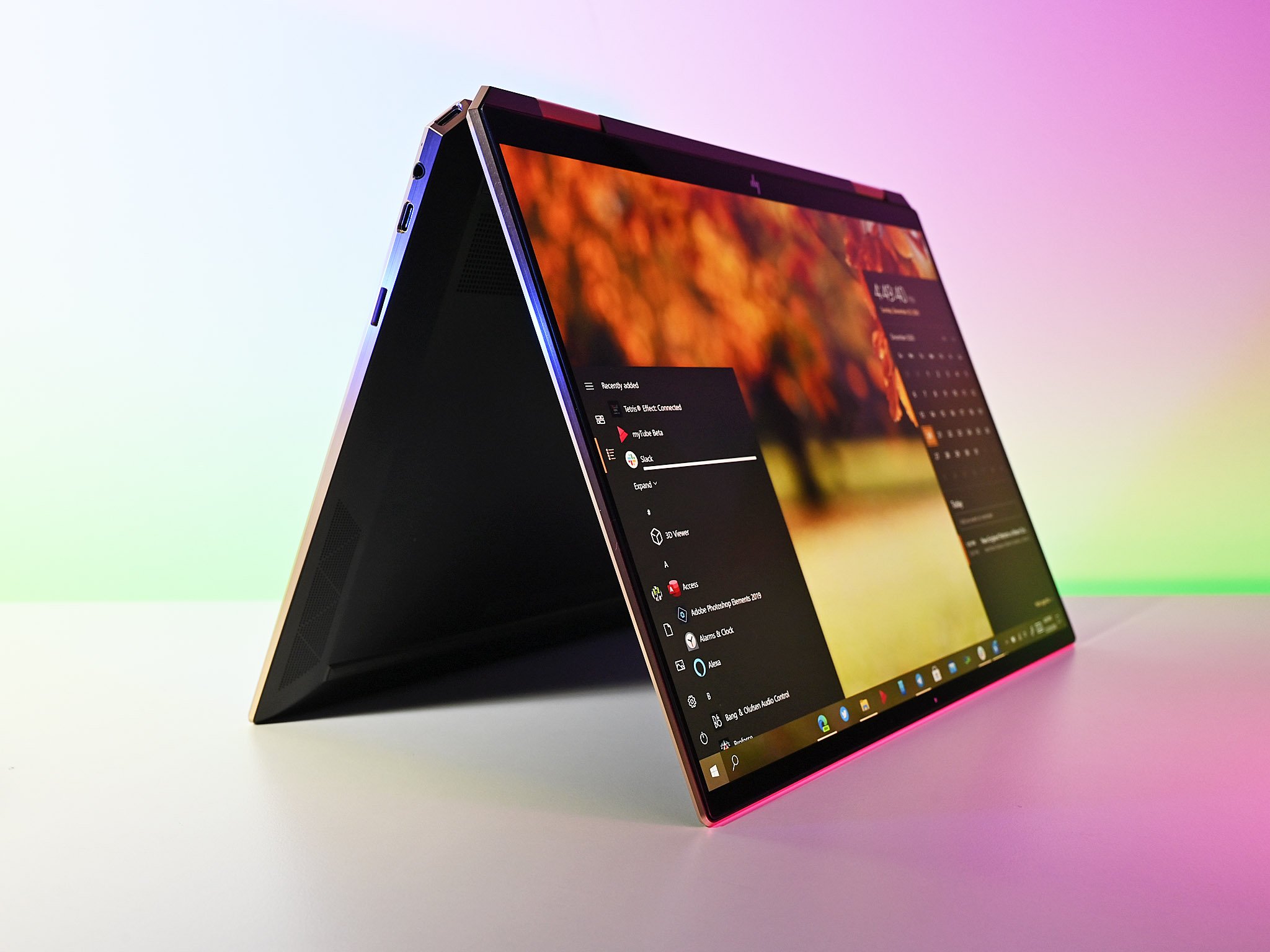There's no shortage of outstanding laptops these days, especially in the 13- to 14-inch range where Intel's Ultrabooks reign king. HP has been building up its Spectre brand for the last few years, and the Spectre x360 14 is in many ways the culmination of the brand into one nearly perfect laptop.
I've spent the last three weeks with the Spectre x360 14, and without reservation, I can say it is the best 2-in-1 Ultrabook on the market today. It displaces the XPS 13 2-in-1, but only slightly, with the significant differences being price and personal preferences.
What makes the Spectre x360 14 so impressive? It's not just the 3000 x 2000 OLED display, but also all the small OS tweaks that HP has made. There is also some of the best audio I have heard on any Windows PC.

From $1,329 at HPSee at Best Buy (OLED)Bottom line: The Spectre x360 14 brings a gorgeous 3:2 display, outstanding quad speakers, excellent trackpad, and just the right number of ports to this top tier convertible laptop. Powered by Intel 11th Gen processors, all-day battery life, and an option for a stellar OLED display, this laptop is nearly flawless.
For
- Amazing 3000 x 2000 OLED display
- Pen and leather cover included
- Exceptional amped quad-speakers
- Intel 11th Gen delivers long battery life, instant-on
- Excellent trackpad and keyboard
Against
- No option for LTE
- Slight looseness to the trackpad
- More expensive than Dell XPS 13 2-in-1
What you get
HP Spectre x360 14 (2020) specs and features
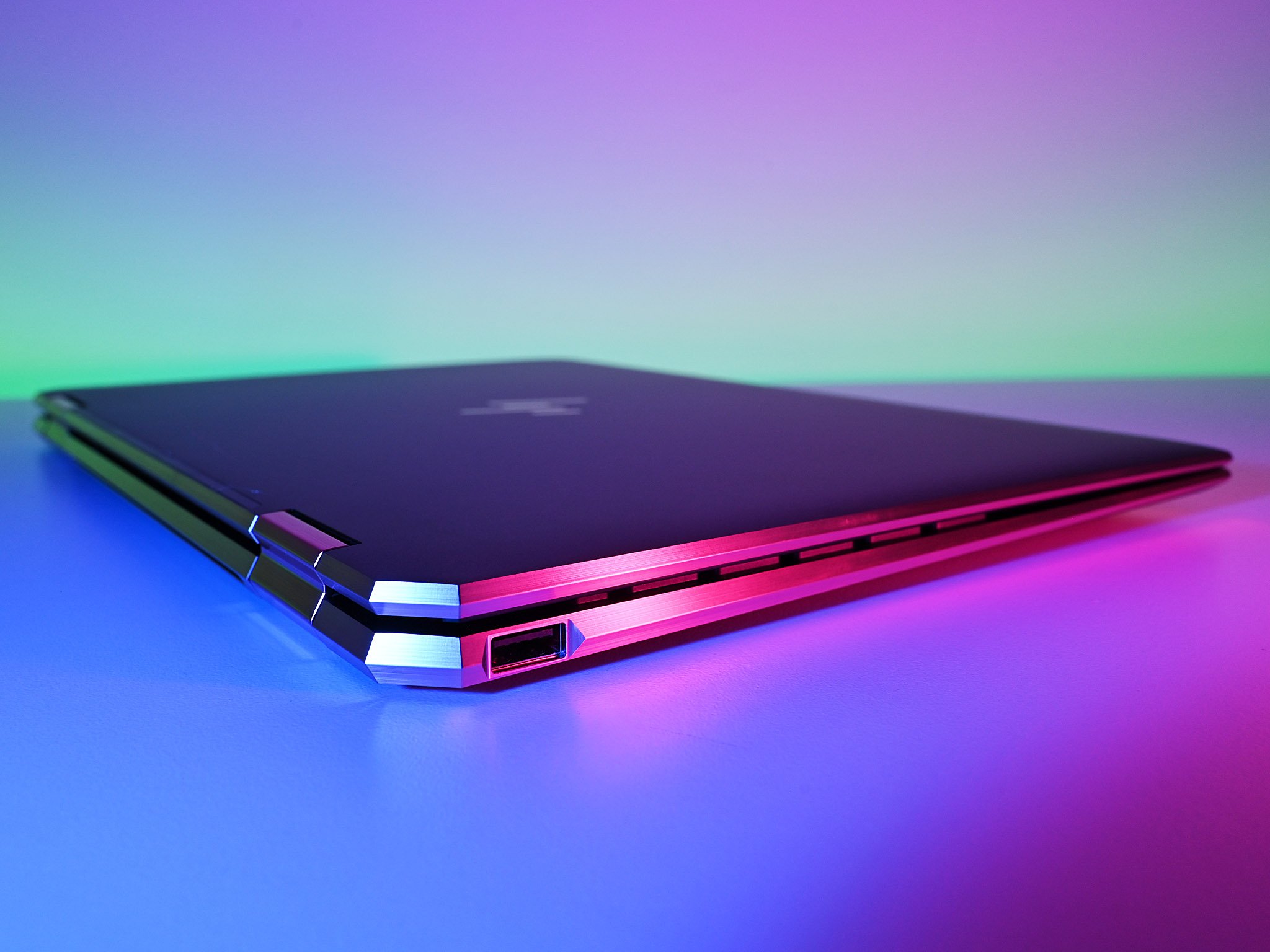
The Spectre x360 14 is classified as a premium convertible 2-in-1 Ultrabook, meaning it does not have a discrete GPU. Instead, the Spectre is powered by Intel's latest 11th processors and uses new Intel Iris Xe graphics.
Being a convertible laptop means it can transform into a tablet, go into "tent mode," or be used with the keyboard flipped behind it, making it ideal for video consumption.
| Category | HP Spectre x360 14 |
|---|---|
| OS | Windows 10 Home |
| Display | 13.5 in, 3:2 aspect ratio1920 x 1280 LCD touch1920 x 1280 LCD touch with 1000 nits and Privacy Screen3000 x 2000 OLED, multi-touchAnti-reflectionCorning Gorilla Glass NBT400 nits, 100% DCI-P3; 1,000,000:1 |
| Processor | 11th Gen Intel Core i7-1165G7 (quad-core) |
| Graphics | Intel Iris Xe |
| Memory | 16GB LPDDR4-3200 |
| Storage | 1TB SSD and 32GB Intel Optane |
| Pen | HP Rechargeable MPP2.0 Tilt Pen in nightfall black (included) |
| Expandable storage | MicroSD reader |
| Front camera | HP TrueVision 720P HD IR camera |
| Security | Windows Hello IR, fingerprint |
| Connectivity | Wi-Fi 6, Bluetooth 5 |
| Ports | Two Type-C with Thunderbolt 4One USB 3.1 Type-AMicroSD reader |
| Audio | Bang & Olufsen with quad speakers |
| Battery | 66WHr65W Type-C AC adapter |
| Dimensions | 11.75 in (W) x 8.67 in (D) x 0.67 in (H) |
| Weight | 3.00lbs1.36kg |
| Colors | Dark Ash, Poseidon Blue, or Silver |
| Availability | October/November |
| Price | Starting at $1,329 |
In the box, HP includes its smartpen and a leather sleeve to protect the Spectre in transit. It's a rare move that only HP does these days and, when combined with its typical lower prices, adds some excellent value. That sleeve also has a pen loop, which is good since the pen has nowhere to go on the Spectre itself.
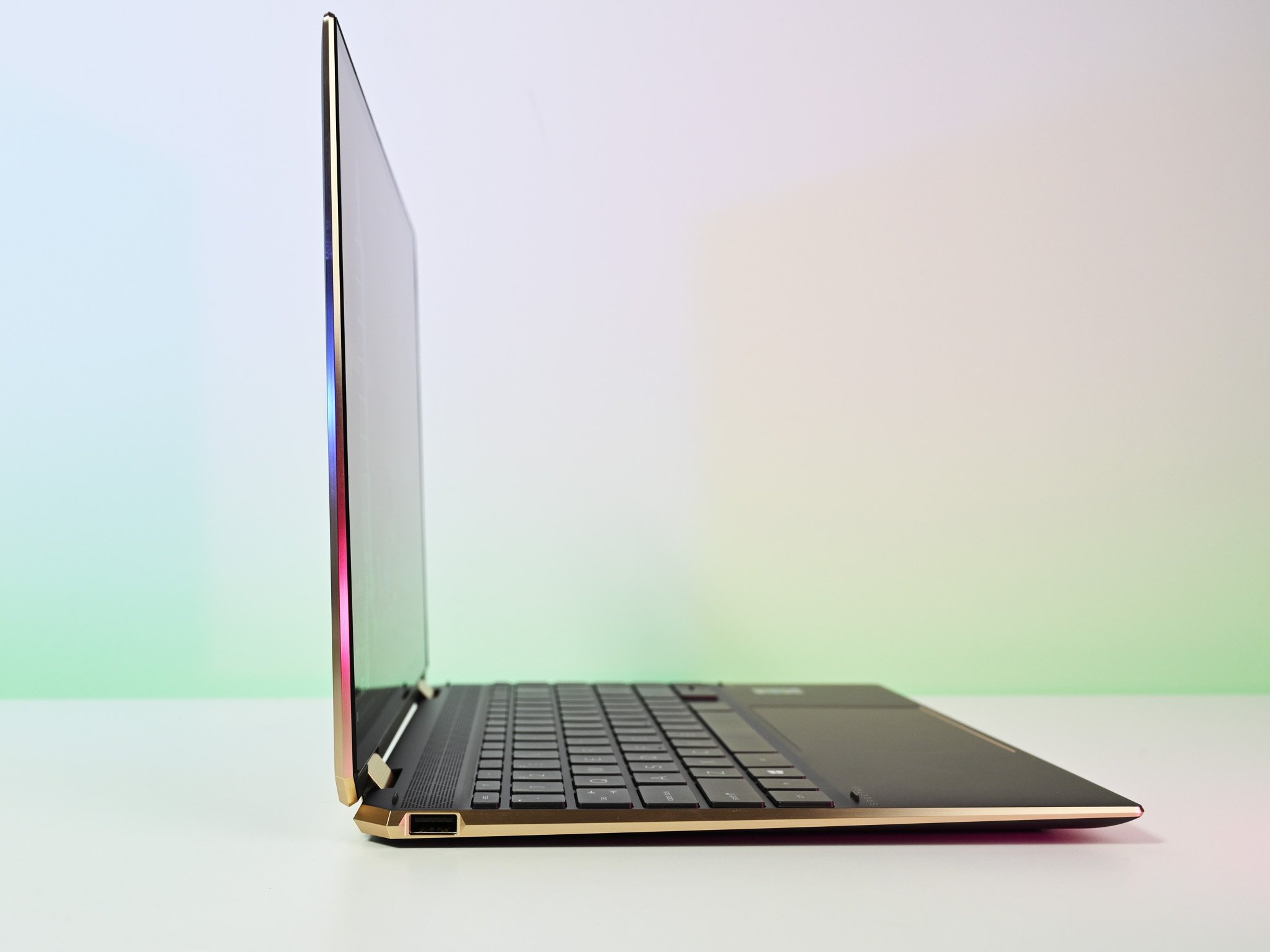
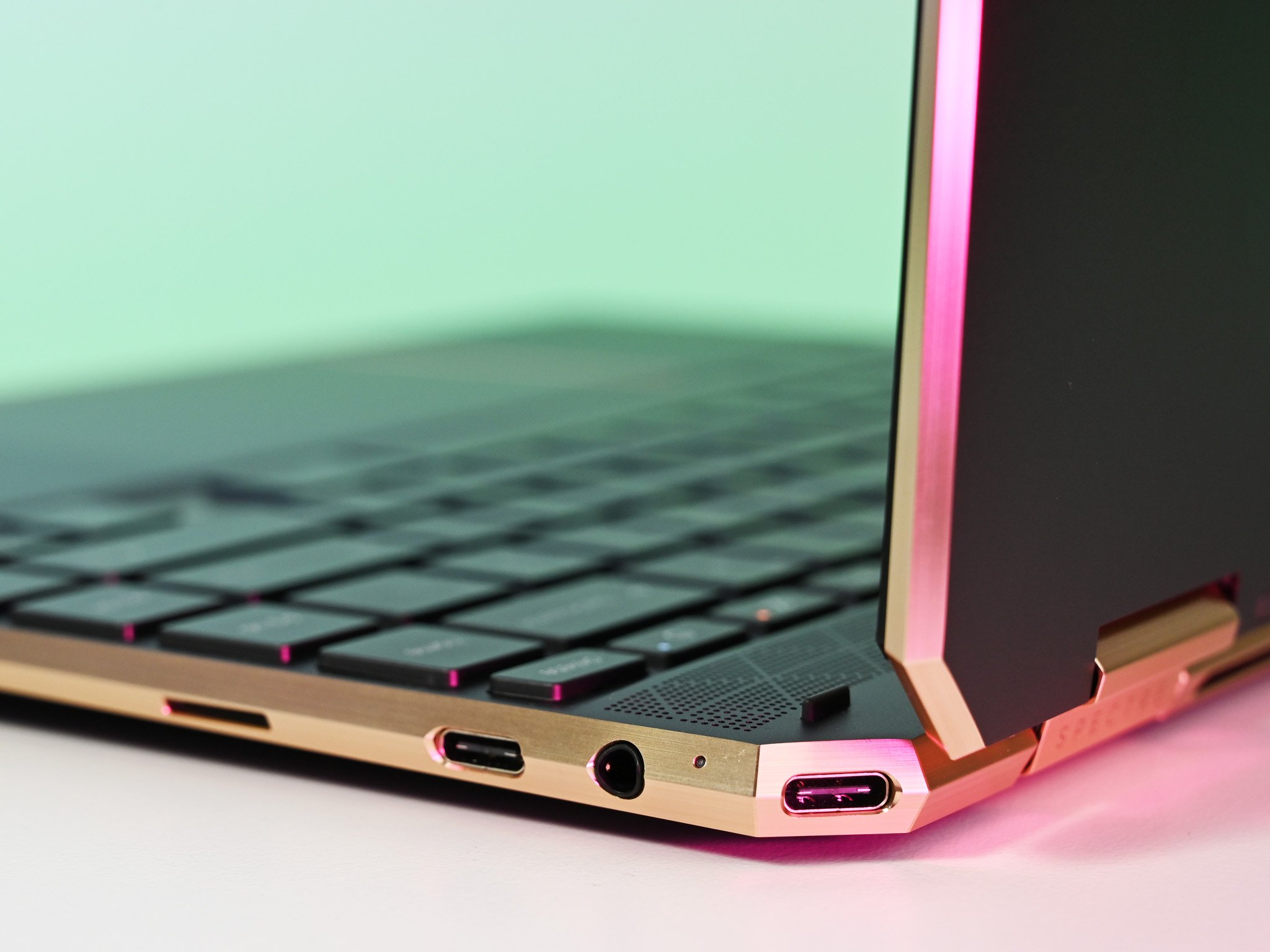
Ultrabooks are losing more ports every year, and the Spectre x360 14 doesn't do anything special, but it does offer a nice balance. There are two USB Type-C with Thunderbolt 4 ports, a micro-SD, and headphone jack all on the right side, while a single USB Type-A port is on the left, which is welcomed.
Without reservation, the Spectre x360 14 is the best 2-in-1 Ultrabook on the market today.
HP is still using its gem cut style with hard angles included cut off rear corners for design. The right corner doubles as one of two Type-C ports, which lets you shoot the cable off in such a manner as to clear the side of the laptop. This ability gives more room for your mouse, should you choose to use one. HP's design is excellent, but some may find it a bit too ornate.
Security and privacy are improved with a Windows Hello infrared (IR) camera for face recognition and an optional fingerprint reader built into the deck. HP also used dedicated keys to disable the camera and microphone.
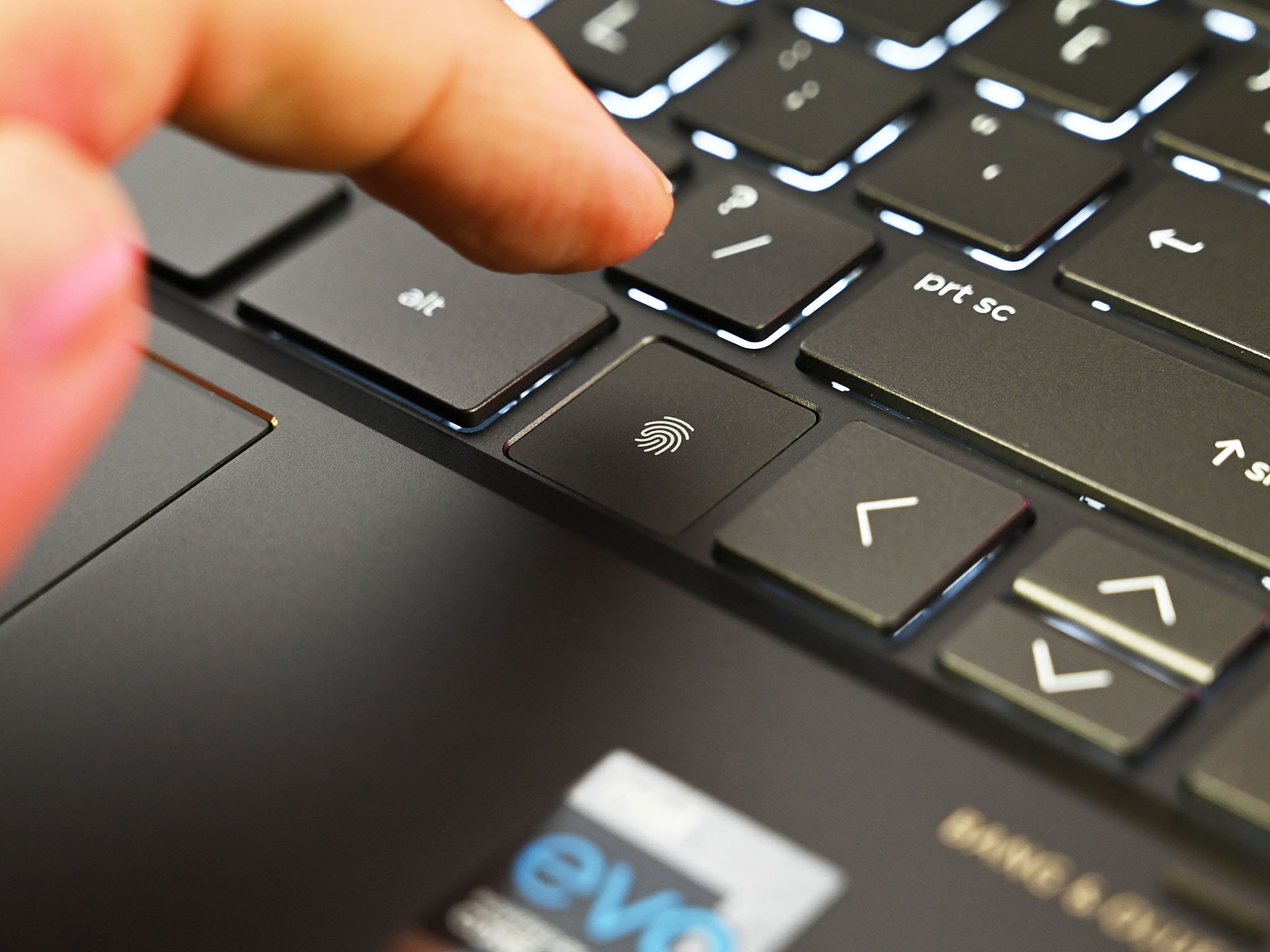
HP offers three colors for the Spectre's chassis. We are using Nightfall Black, which is matte and almost like a black/brown mix with dark gold accents, for this review. There is also a more straightforward natural silver option for those who want something less attention-grabbing. There's a third color dubbed Poseidon Blue, which, as the name implies, is bluer and has a lighter gold accent.
At three pounds (1.36kg), this is not a light laptop by today's standards, but the all-metal chassis makes up for that in giving a pleasing, quality feel to the overall design. Part of that weight is also due to the nicely sized 66 WHr battery (many Ultrabooks hover around 50 WHrs), which pays off in our tests.
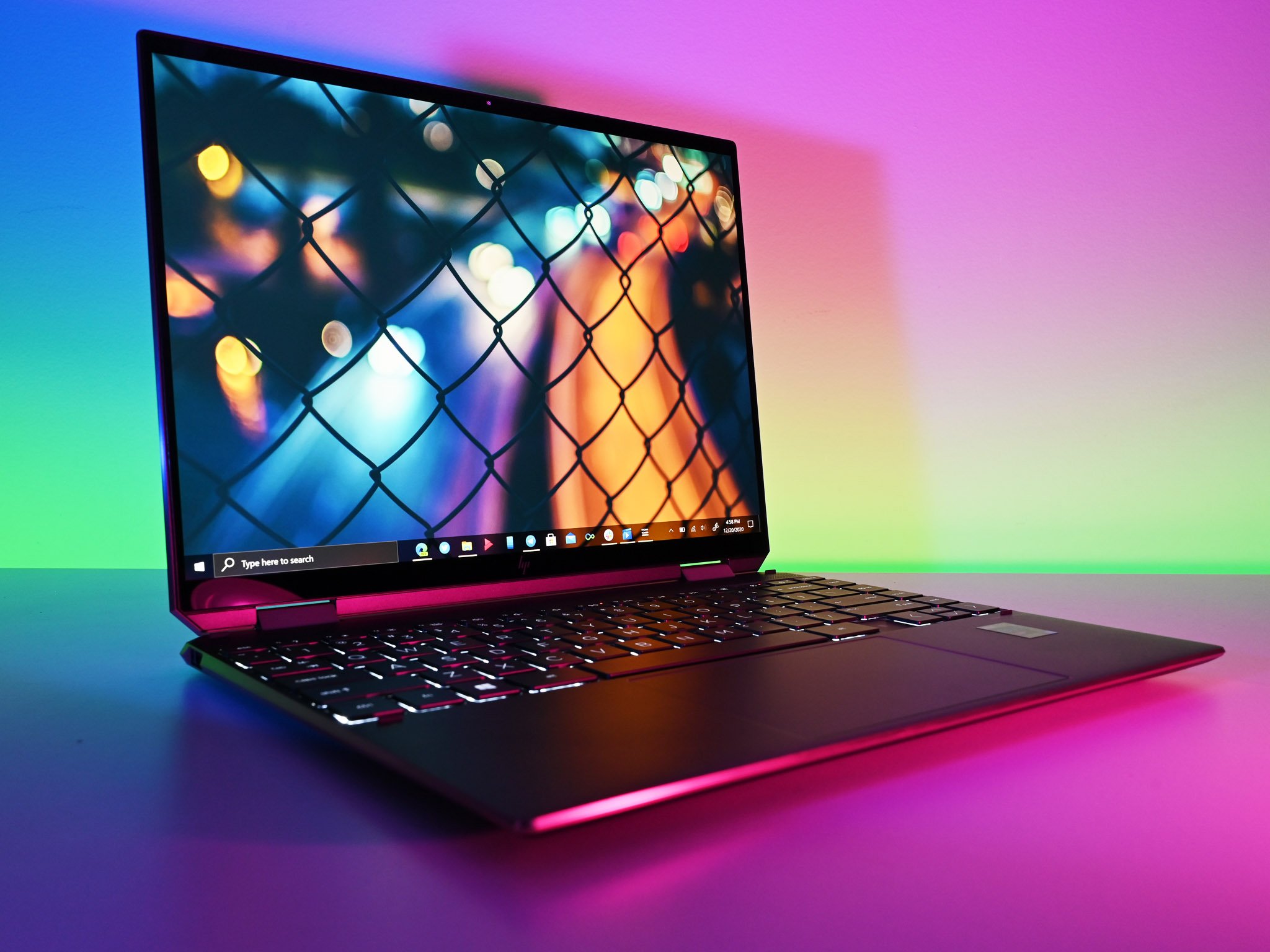
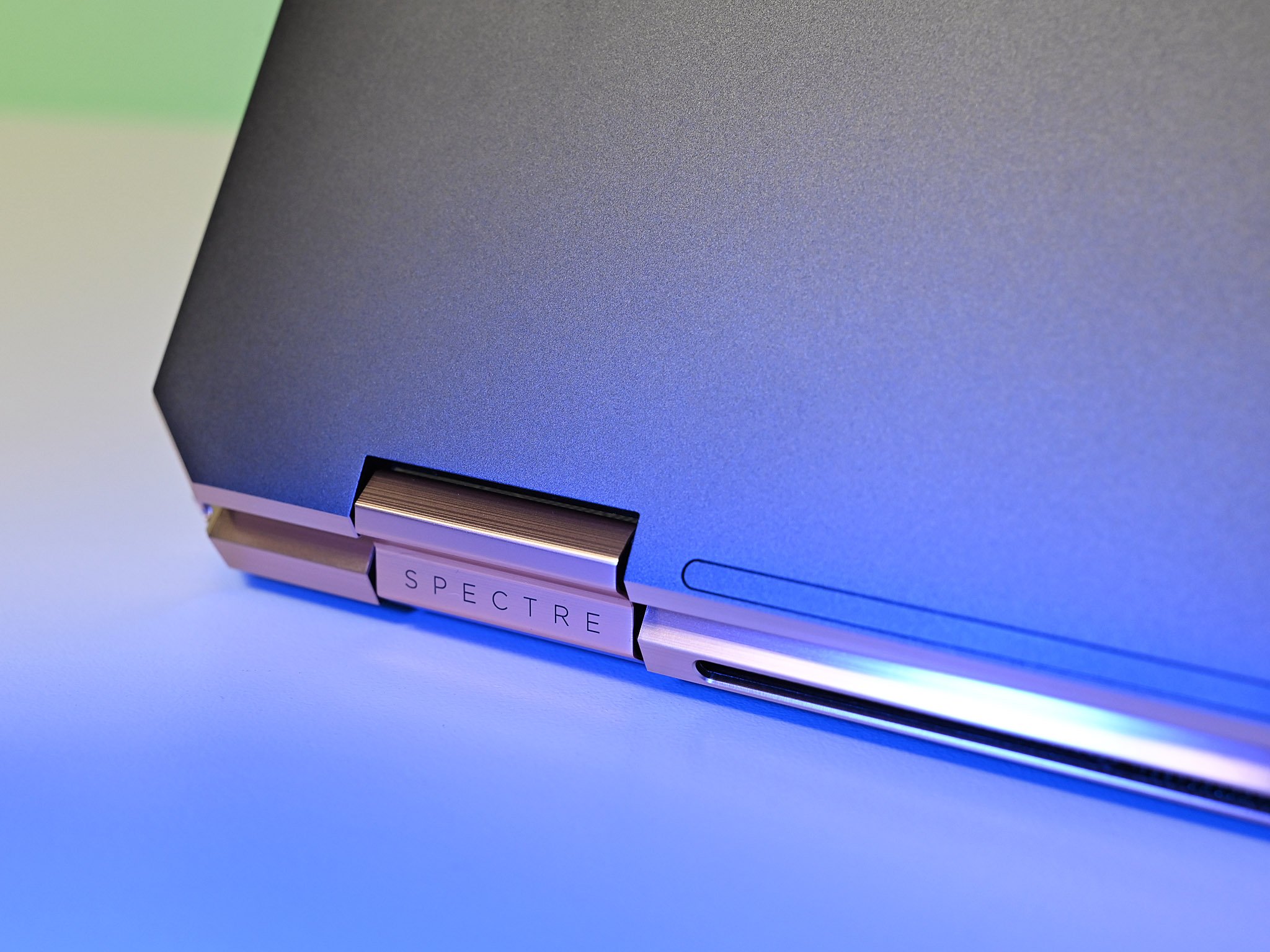
Another sign of quality is the ability to open the Spectre with one hand. While this a moot highlight, it's still an engineering challenge when you have 360-degree hinges and a heavier touch display that supports inking. Companies like Lenovo still have a tough time with this capability.
OLED done right
HP Spectre x360 14 (2020) display and web camera
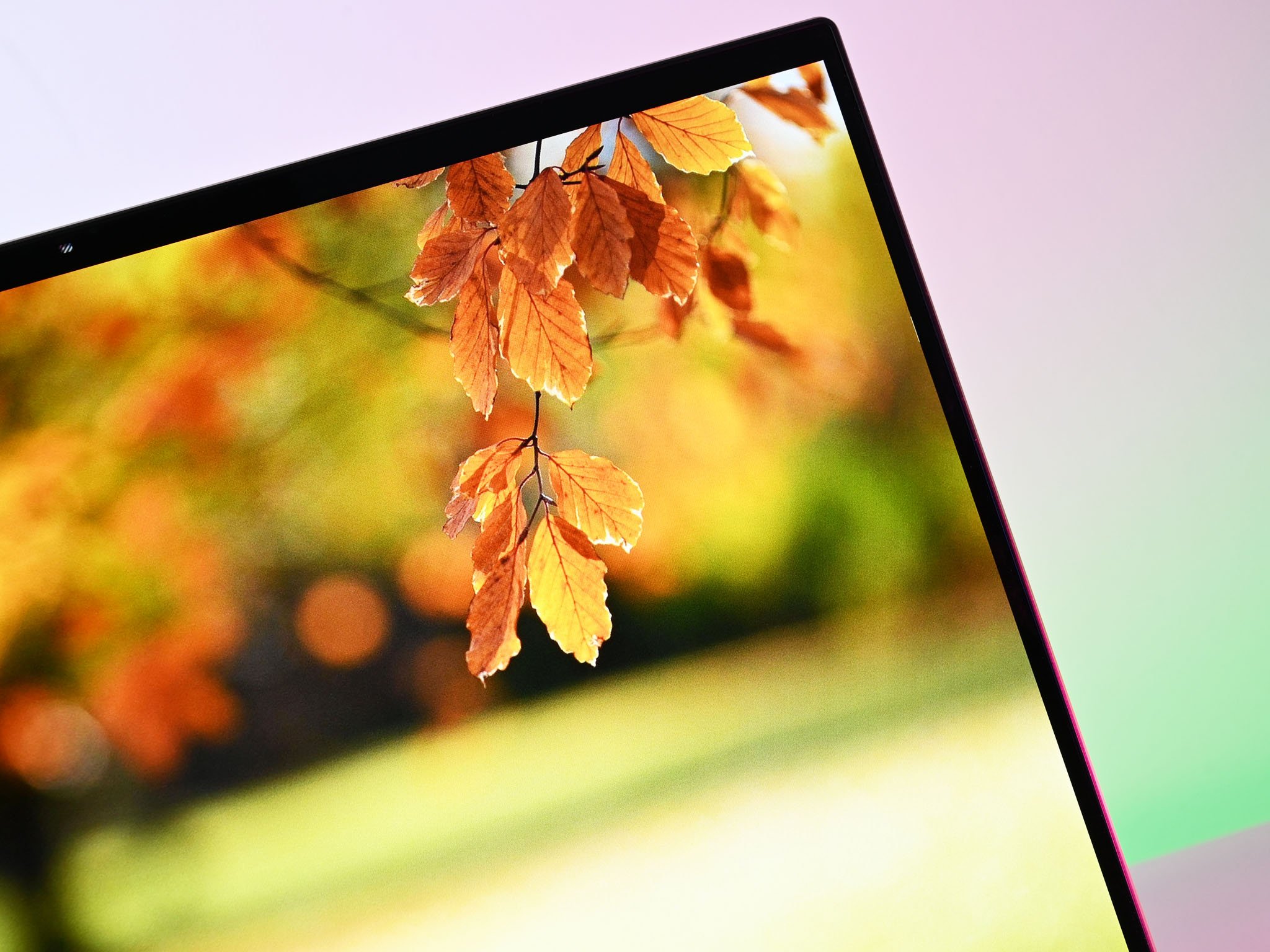
The Spectre has an incredibly unique 3:2 display aspect, something only found on Microsoft Surface devices, and increasingly hard to find Huawei laptops. It is much taller than 16:9, which is what ships with the Spectre x360 13. HP made the right choice here. With skinny bezels on all four sides, this aspect works at 13.5-inches. It also makes using the Spectre as a tablet or for inking much more enjoyable.
The 3000 x 2000 OLED display is simply stunning, but it's also "smart."
HP offers the Spectre with three display options. One is full HD+ (1920 x 1280) with touch, which is the cheapest option. There is also a full HD+ with HP's Sure View privacy screen, which can hit up to 1000 nits of brightness. Both of those are typical LCD panels with excellent color accuracy and ideal for better battery life.
The third model, which I am using for this review, is the high-end version featuring a 3000 x 2000 resolution and OLED. This one also supports touch and inking like the others. It is simply stunning with its intense blacks and 1,000,000:1 contrast ratio.
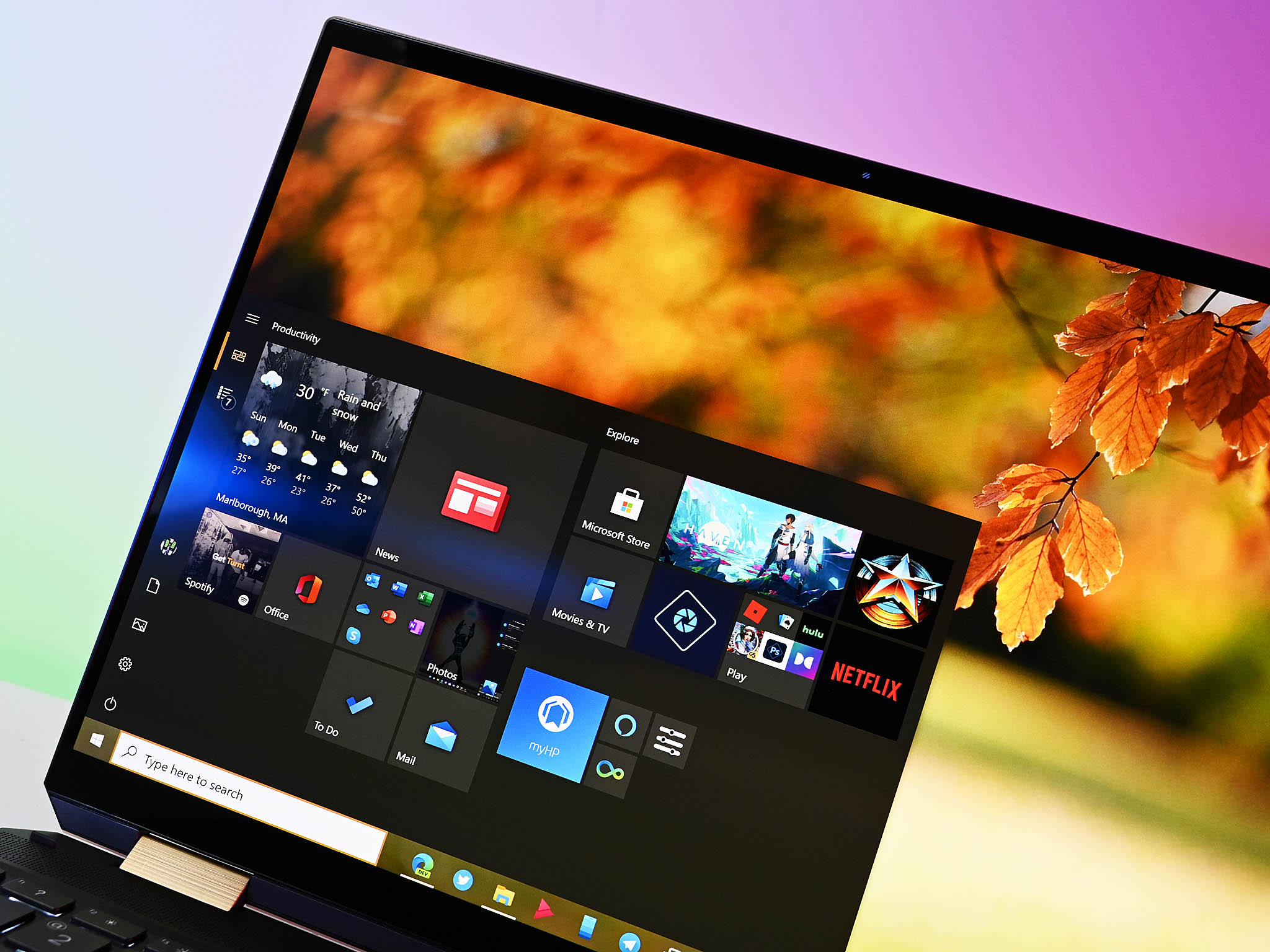
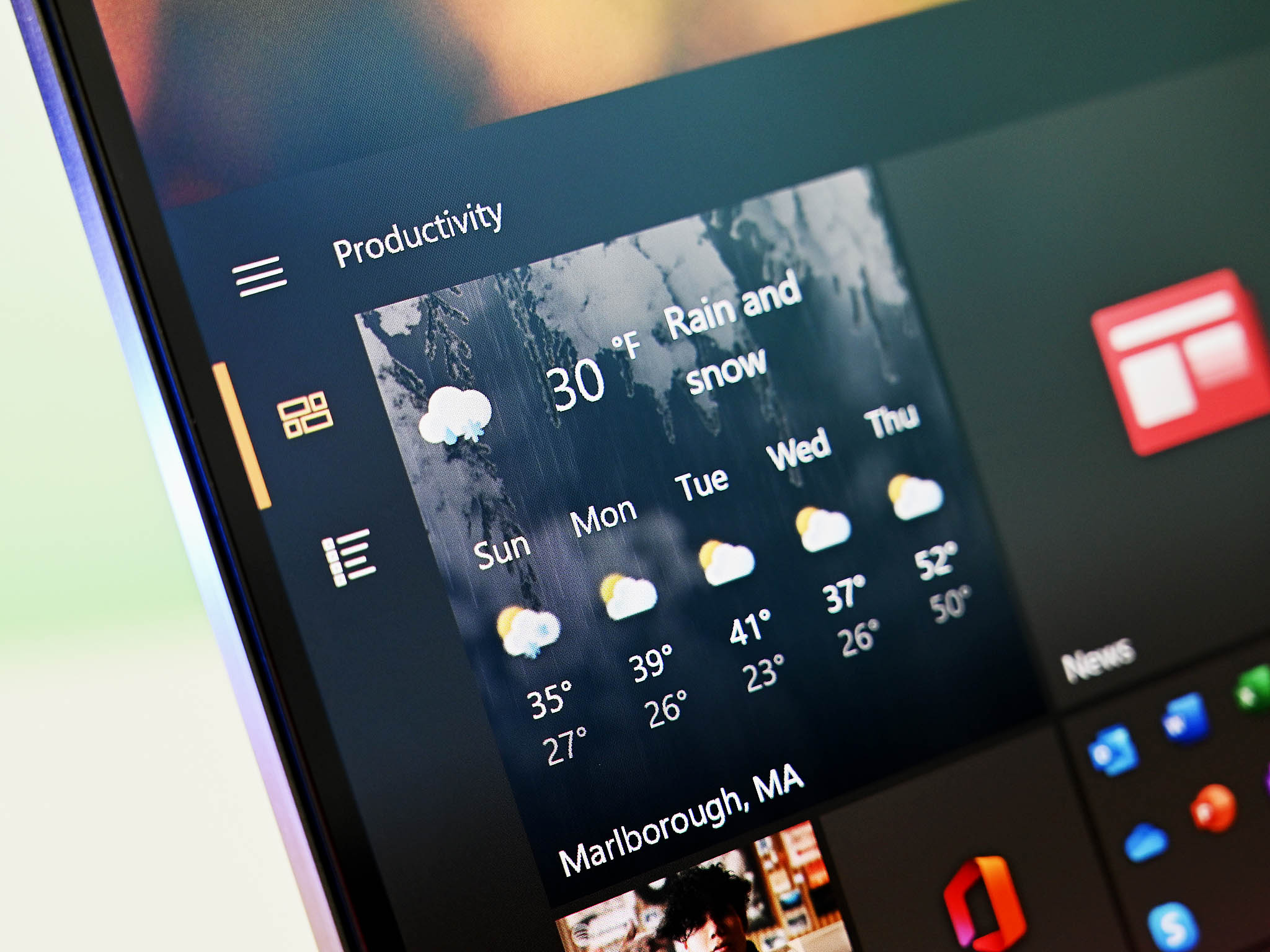
All models have an anti-reflective layer, which helps when using the Spectre under bright lights. Dell still has the best anti-reflective treatment, but the Spectre's is still excellent. HP also uses an auto-brightness sensor, which is still something many laptops do not include.
Color accuracy is average with 98 percent sRGB, 76 percent AdobeRGB, and 78 percent DCI-P3. Brightness only peaks at 344 nits (slightly below the rated 400 nits), but it looks much brighter than an LCD due to the extremely high contrast. The minimum brightness is just 21 nits making this laptop easy to use in a dark room.
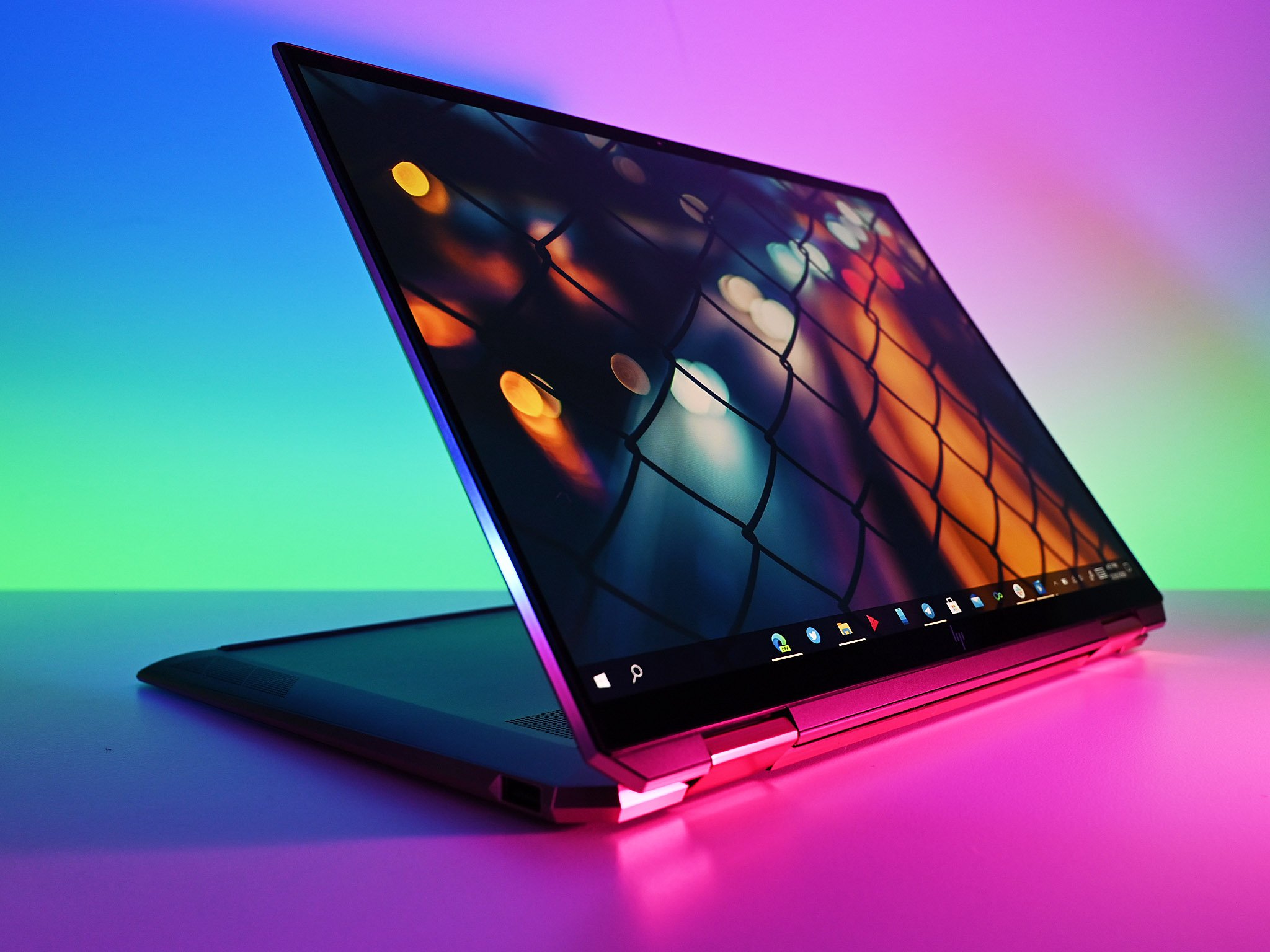
Typically, I am not a massive fan of OLED. While it looks incredible the first time, after a while, it becomes too intense for simple tasks like reading email or the web due to that high contrast ratio. But HP did something fascinating and solved this OLED problem. The Spectre has an app called HP Display Control that can auto-switch color profiles depending on the app you are using. Editing in Photoshop or watching a movie? The Spectre switches to DCI-P3. Web browsing? Switch to sRGB. Users can set these profile switches for any app they want, and it all happens instantly with a blink of an eye. It's a genius answer and worked without a hitch.
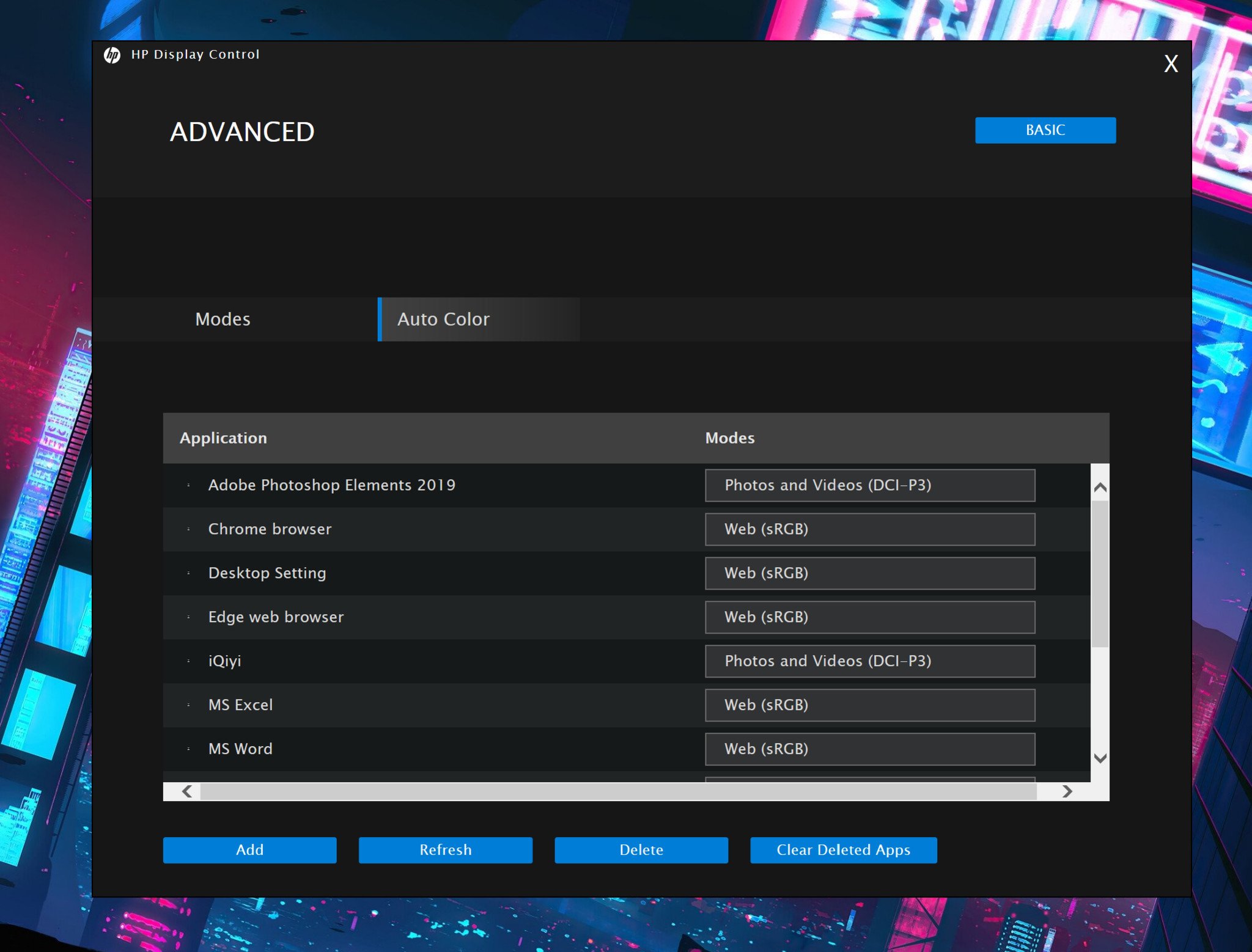
Another matter with OLED is the higher-than-average power draw. Again, HP has an answer: Focus Mode. Toggling this feature keeps your current Windowed-app fully lit while the desktop (or any background Windows) gets dimmed. This trick lets your eyes focus on the task at hand with fewer distractions while also reducing power consumption (OLED can do this since each pixel is individually lit). It can be a bit weird at first, but you get used to it after some usage.
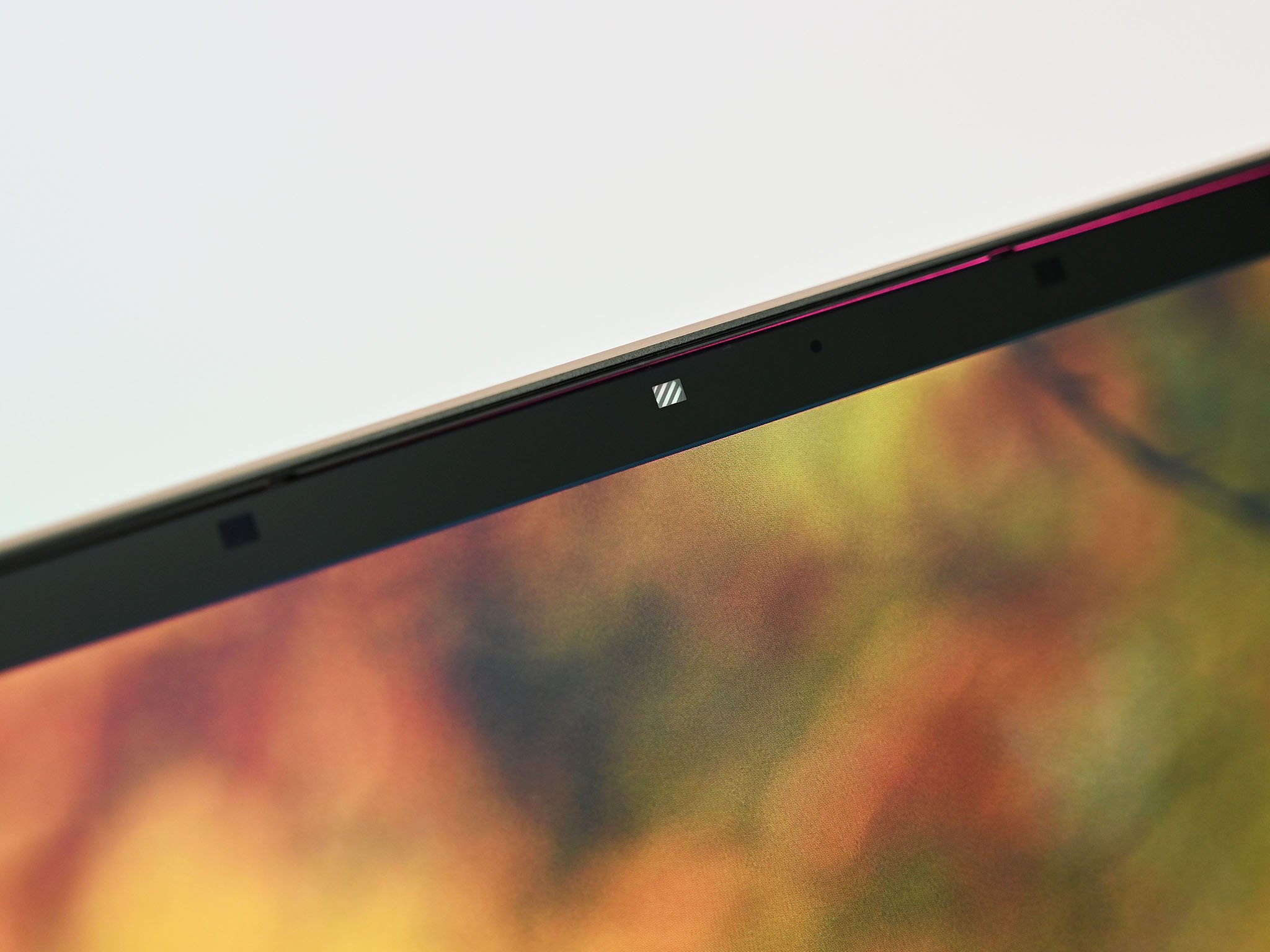
The webcam is nothing extraordinary. HP is learning it can use a large 5MP camera in its new Dragonfly Max Edition, but for the Spectre, it's just a regular 720P camera. It gets the job done. The Windows Hello IR sensor is exceptionally fast. And with a touch of a button, a shutter covers the camera to ensure absolute privacy. This new method replaces the old physical side switch used in other Spectre laptops, which killed the camera electronically. Now, you can see the camera is physically occluded, which is more satisfying.
A great keyboard
HP Spectre x360 14 (2020) keyboard, trackpad, and audio
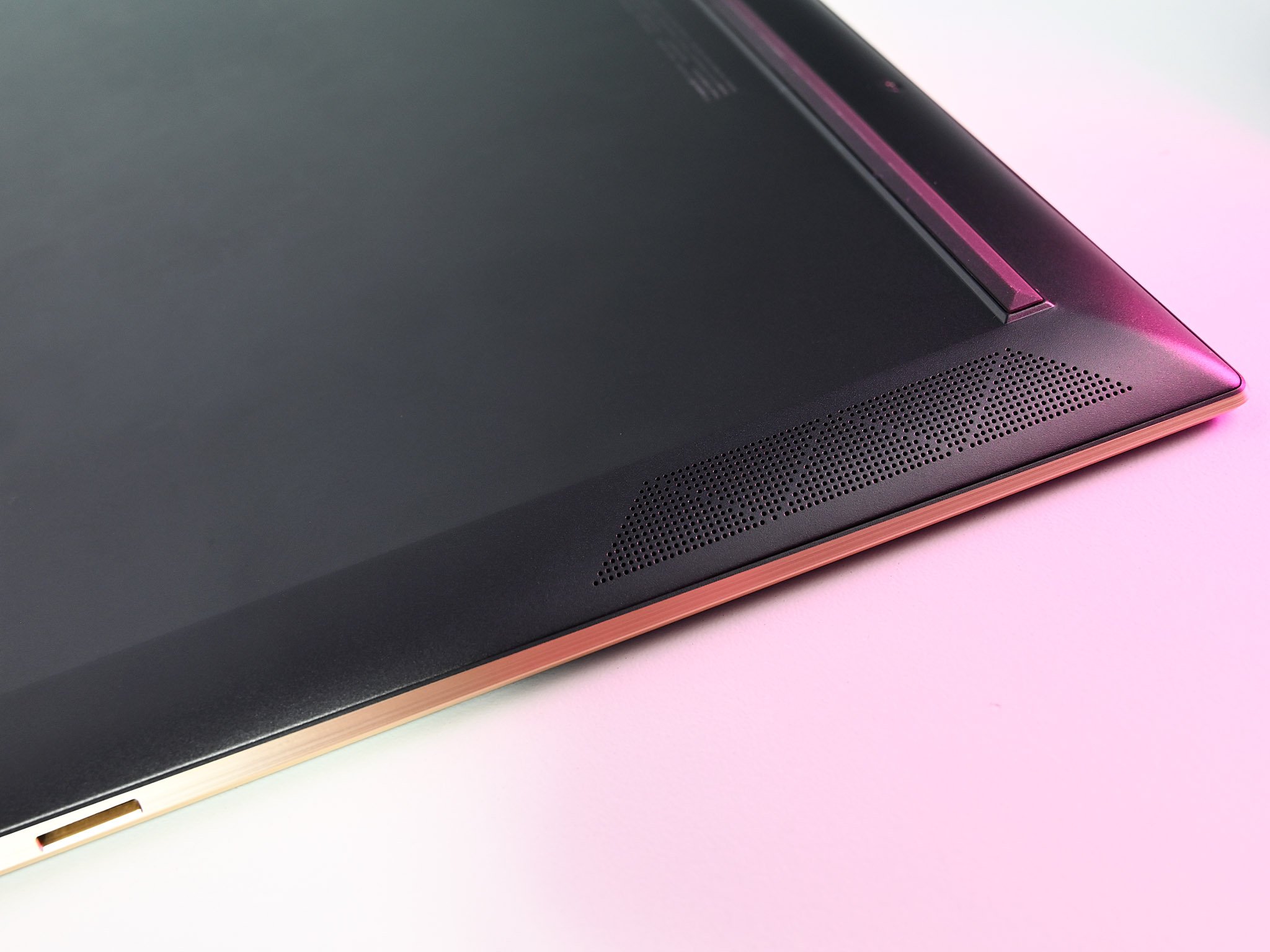
I think HP makes some of the best keyboards out of all the major laptop makers. The Spectre x360 14 does not disappoint. The keyboard is edge to edge, and the individual keycaps are quite large squares with ample and satisfying travel. There is a pleasant stiffness to the keys because there is no wobble. There is also a bit of a bounce-back, which helps with typing fatigue.
The Spectre's audio and keyboard are some of the best of any Windows PC.
The contrast and two-stage backlit keys also make it easy to work in low light on the Dark Ash model.
The trackpad is quite large thanks to the more extended keyboard deck and that 3:2 display and smooth due to the Microsoft Precision drivers. My only minor complaint is the trackpad has a very subtle looseness to it. It's not a rattle (like a defect), just a side effect of having a physically moving touchpad. I'd like to see HP eventually move to newer "force" trackpads without moving parts. That said, I had no issue using the Spectre's trackpad for daily use.
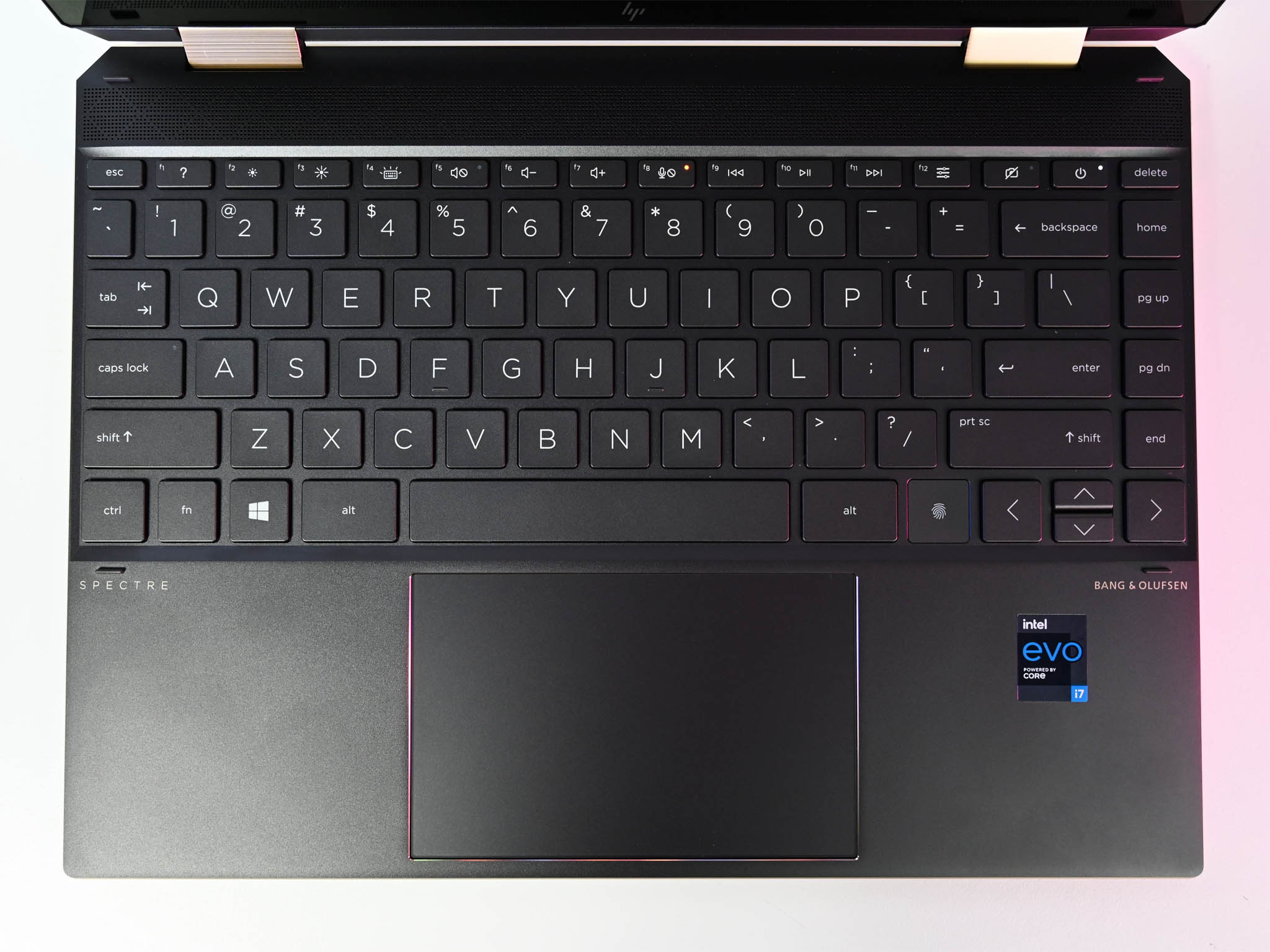
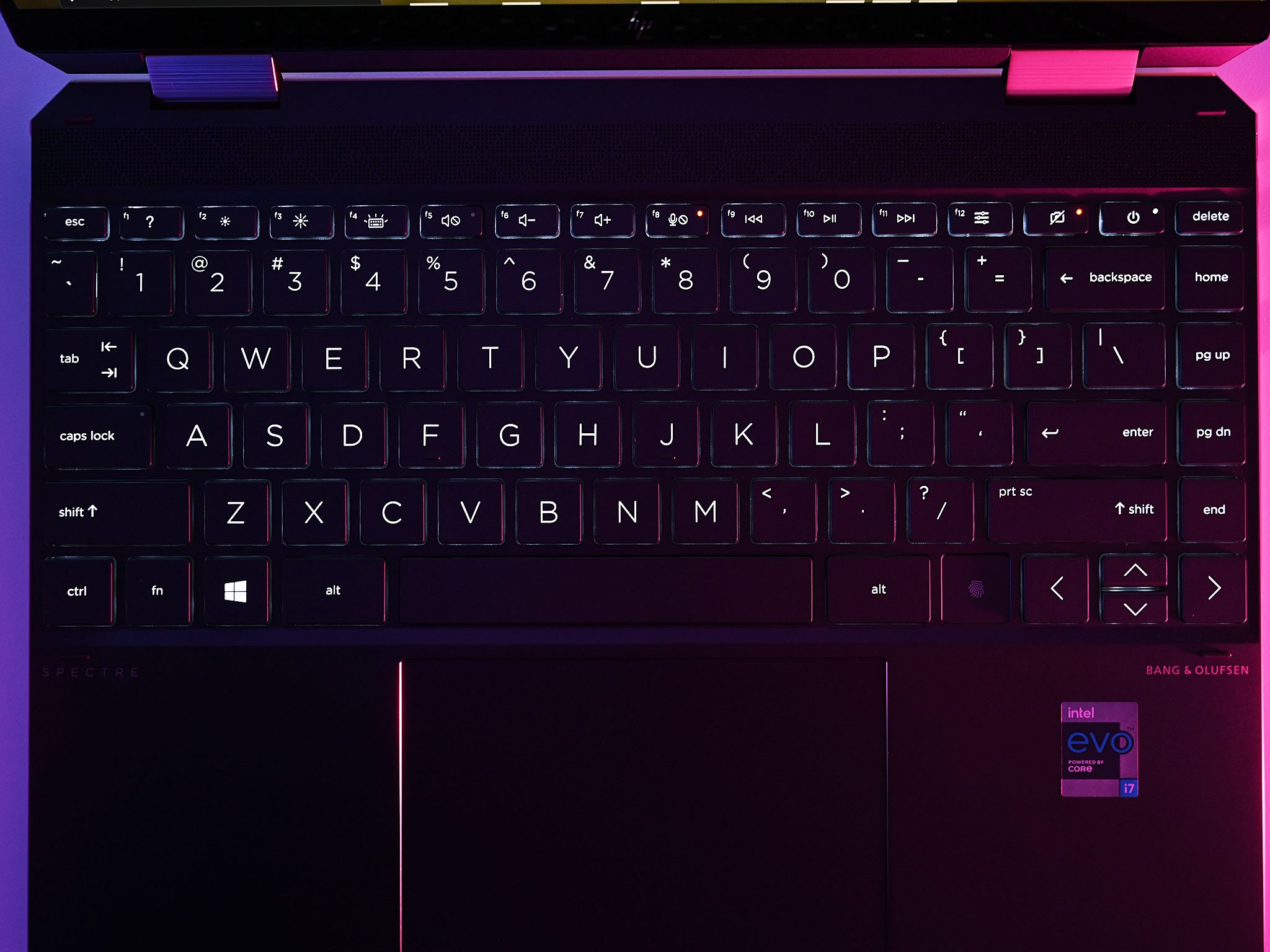
Audio is a compelling point of the Spectre x360 14. A proper convertible laptop has four speakers – two on the top deck for normal laptop usage and two on the bottom for media presentation or tablet modes. HP does that here with excellent pre-amped Bang & Olufsen speakers. Indeed, when you rotate the Spectre into media mode, the speakers on the top deck turn off, which makes sense since they are muffled against a desk or your lap.
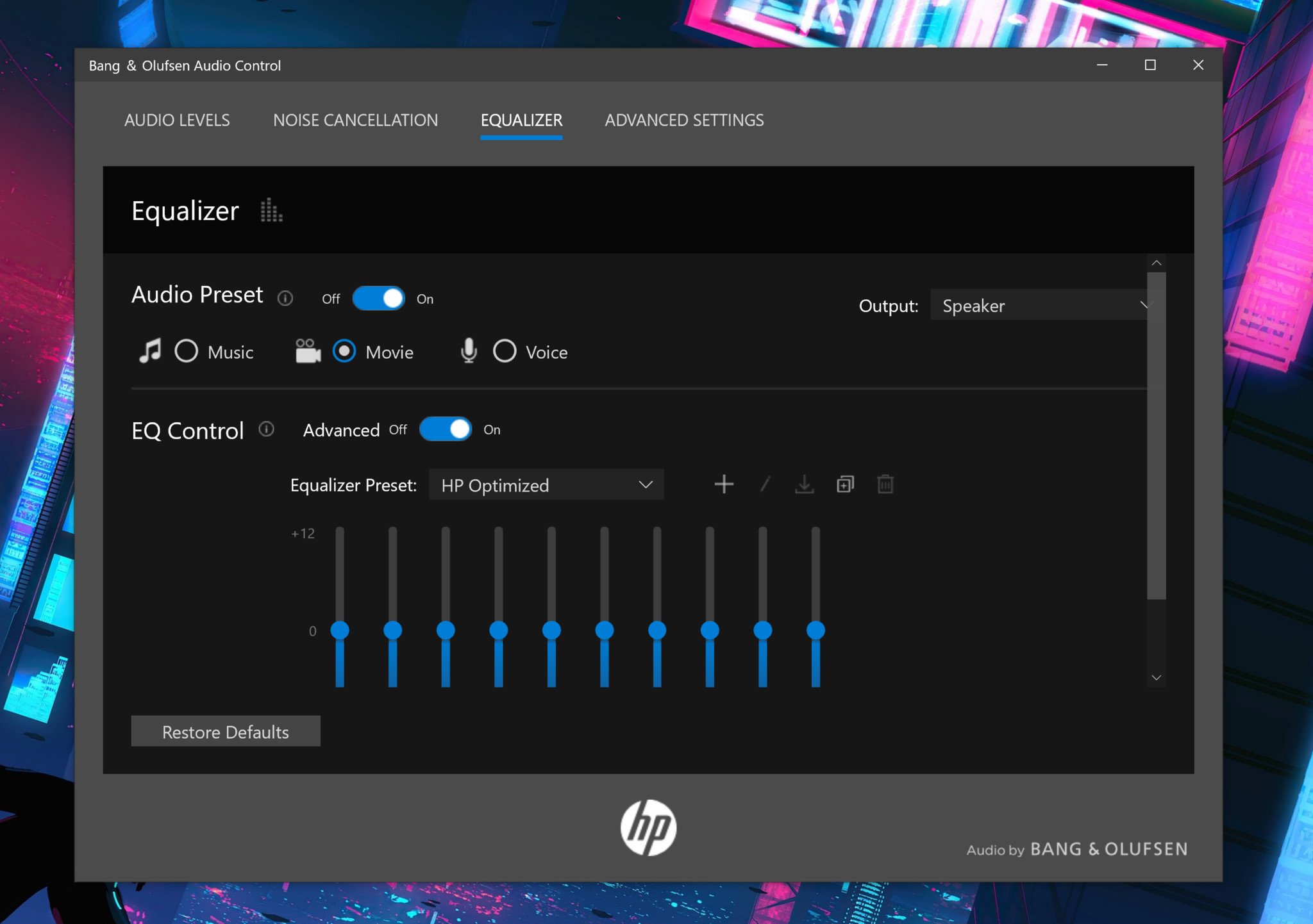
There are tuning options available via the Bang & Olufsen Audio Control app. Users can configure the Spectre for music, movie, or voice (or auto-detect), adjust the 10-band EQ, and enable noise cancellation for the microphones. Volume can get quite loud, and the spatial separation is excellent.
Just the right speed
Spectre x360 14 (2020) power, benchmarks, and battery
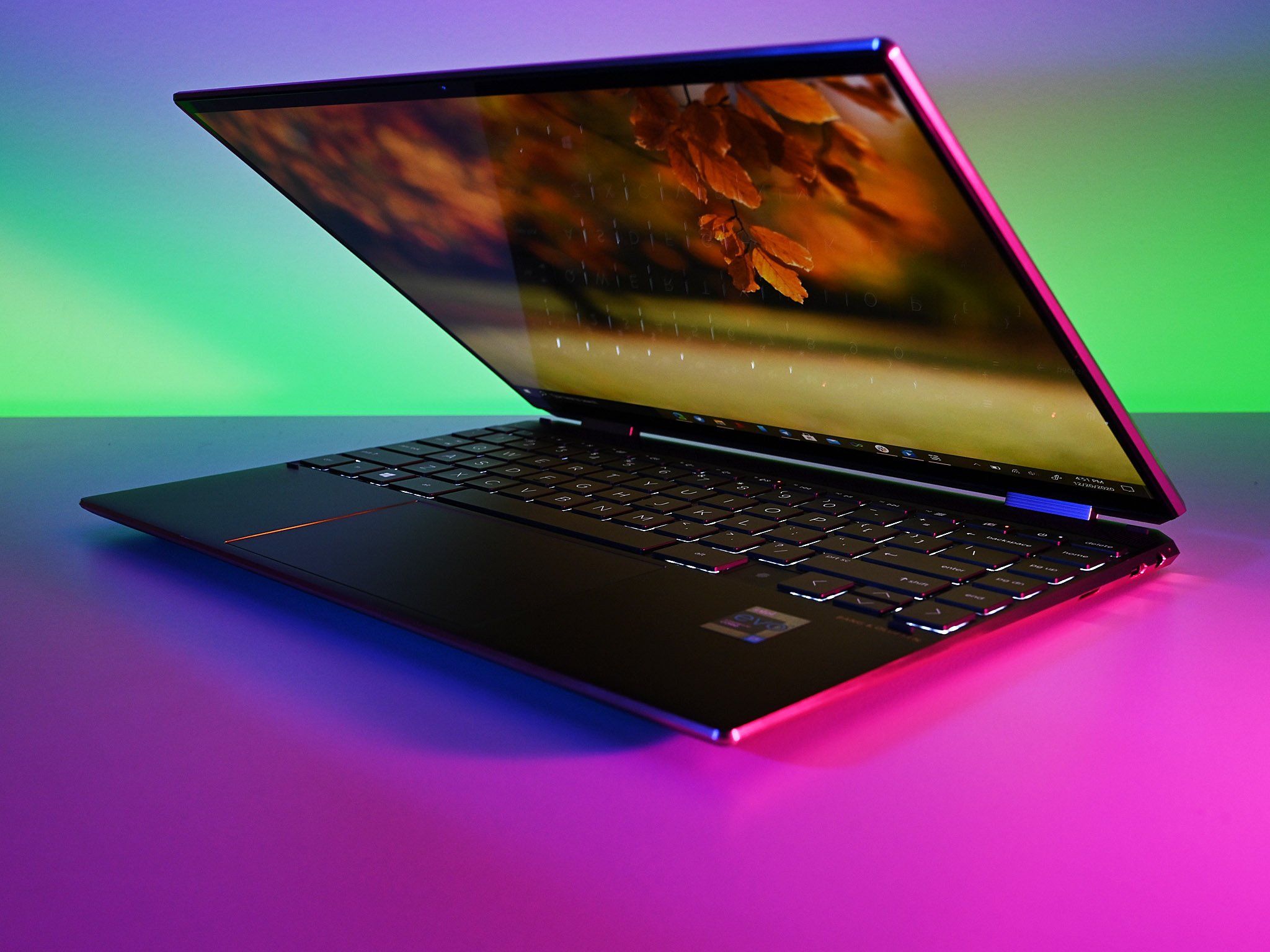
Powered by an Intel 11th Gen Core i7-1165G7 with Intel Iris Xe graphics, the Spectre x360 14 doesn't break any new barriers, but it holds its own against Ultrabooks with similar specs. Like many new laptops, this one is certified to meet Intel's Evo standards, including fast resume, Wi-Fi 6, long battery life, and more.
The closest competitor would be Dell's excellent XPS 13 2-in-1, which achieves higher results in PCMark 10 and Geekbench 5, likely due to Dell's aggressive thermal solutions like Silicon Aerogel. Things even out a bit more on 3DMark Night Raid, where the Spectre slightly edges out the XPS 13 2-in-1, although it is close enough to call it a draw.
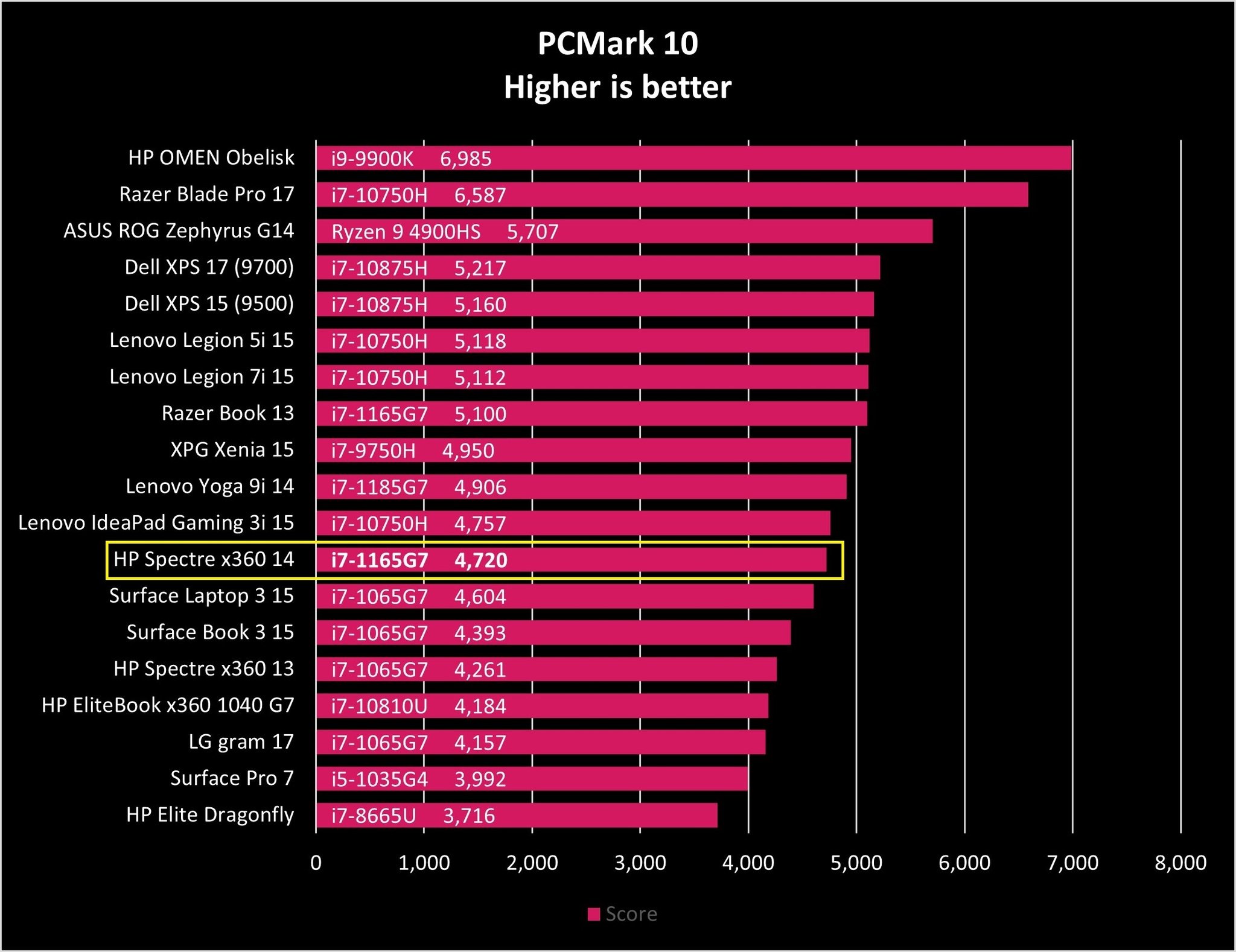
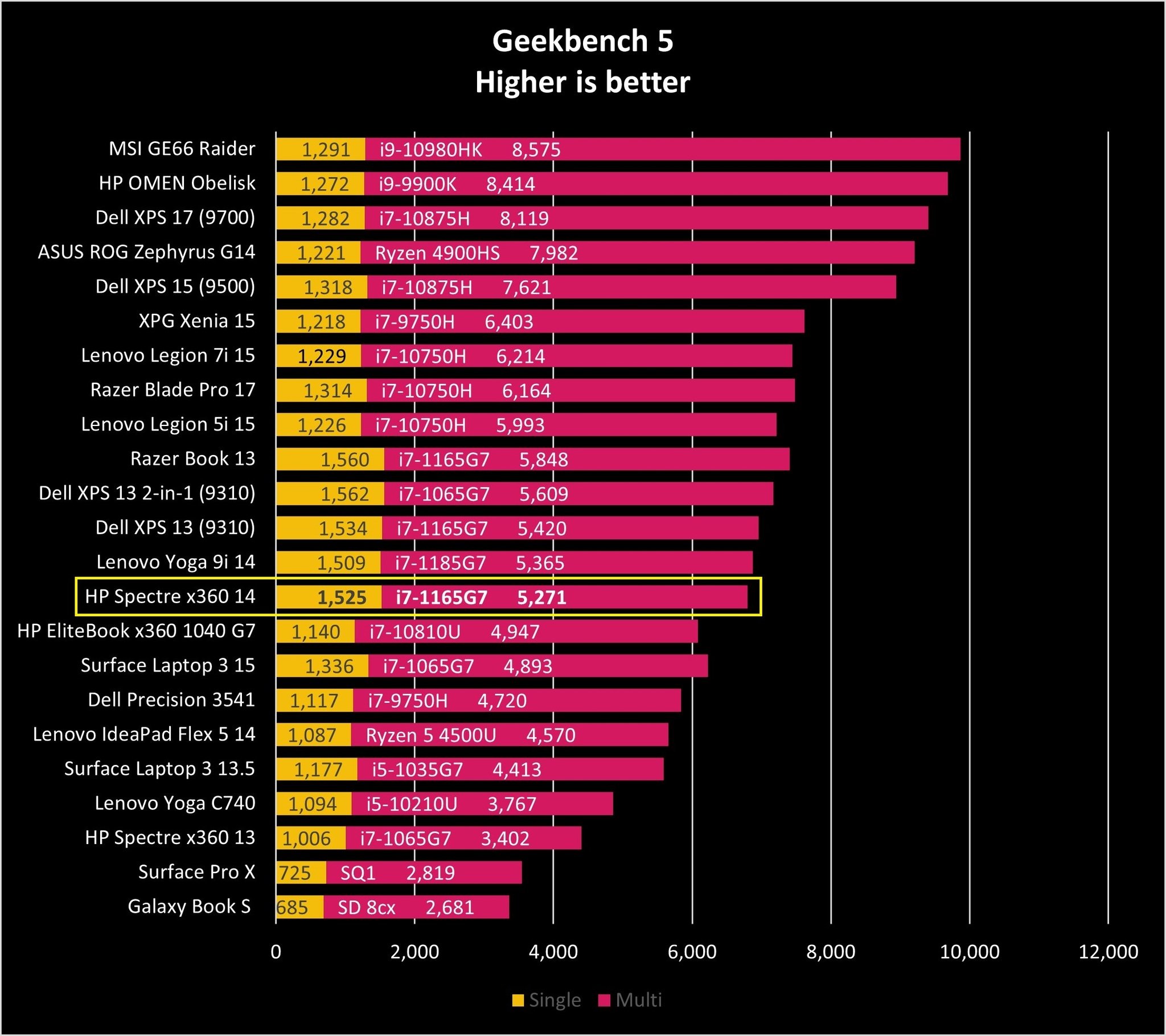
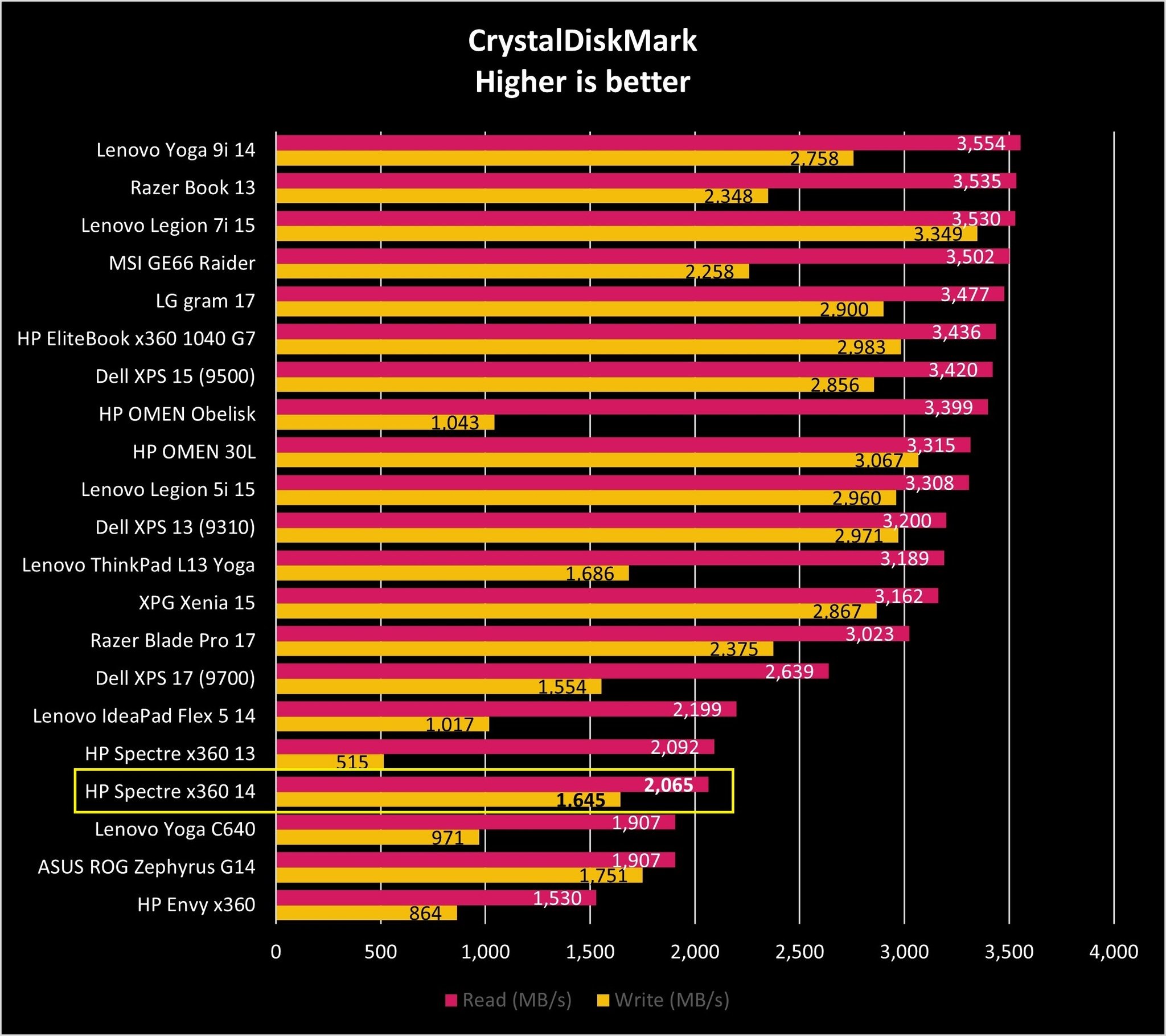
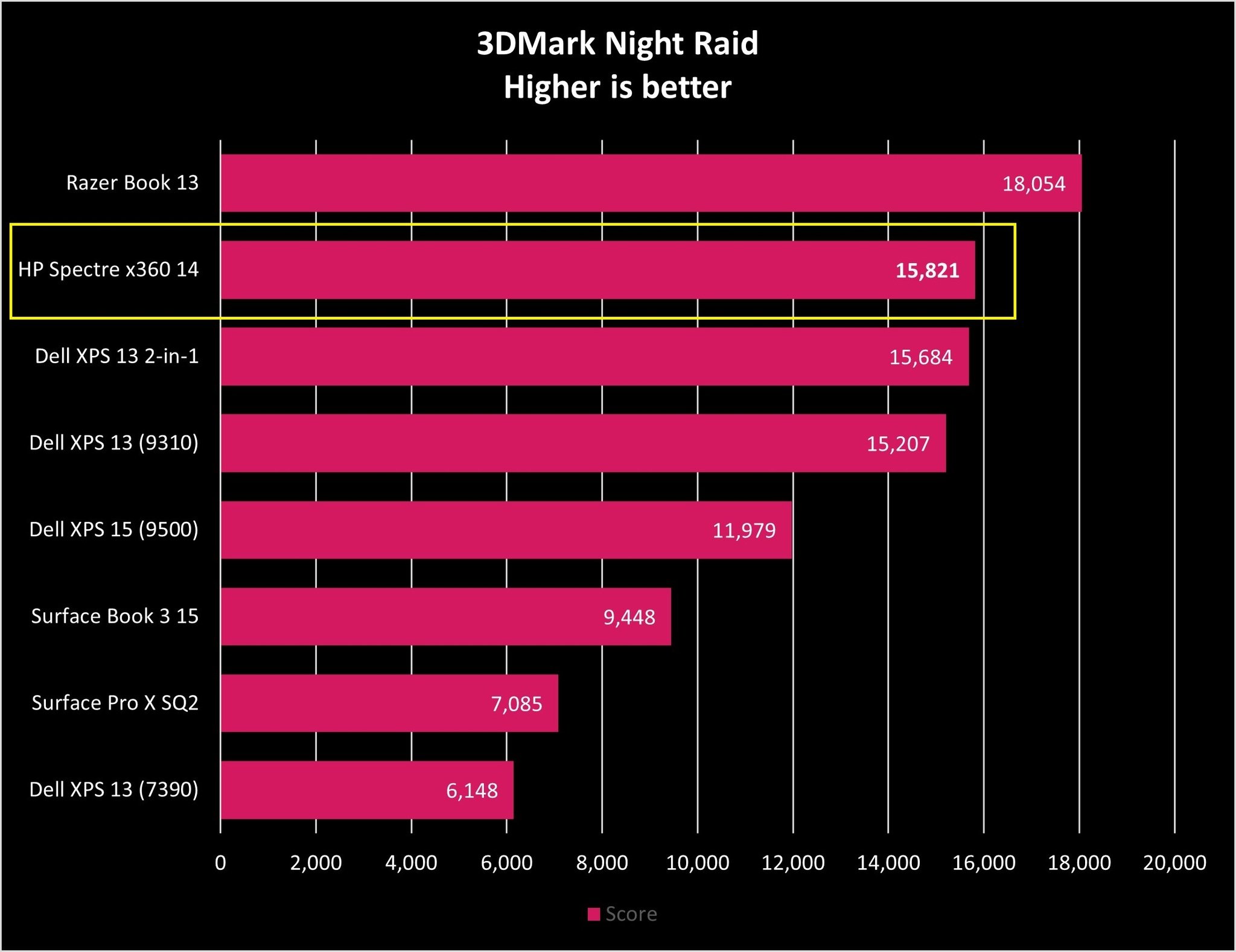
Storage performance is tricky. Going by raw numbers, HP's SSD solution looks slower compared to other modern Ultrabooks by a significant margin. However, HP uses Intel Optane or an SSD fronted with a memory cache system to improve overall performance for apps used most frequently. Since the cache is faster, often used apps get stored there (as well on the SSD) but can be called up more quickly than traditional SSD media.
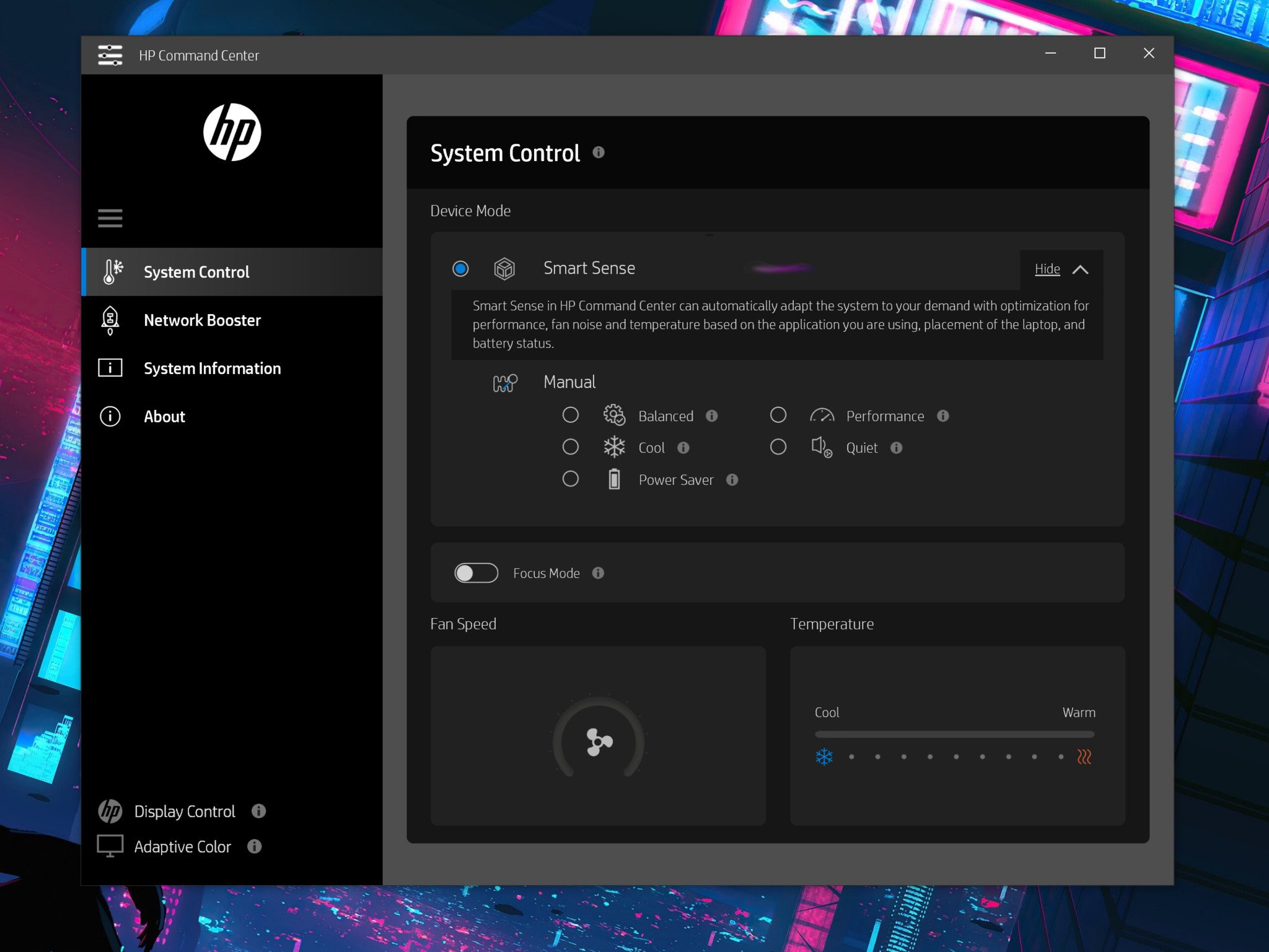
Thermal performance is also outstanding. This is due to HP's well-done fan and cooling system (which now draws air from the top deck where the speaker grills are), but also because of software. HP's Command Center app has a "Smart Sense" setting, which lets the PC auto-adapt thermal performance based on the type of app, battery status, and how the laptop is being used (lap or on a desk). For instance, if you are using the Spectre on our lap, the battery is OK, and you're running the web browser, CPU performance won't max out because it's not needed. Fire up Photoshop while plugged in and on a desk, and the system goes full throttle. It is a cunning system that works very well, and I barely heard the Spectre's fans for regular productivity usage.
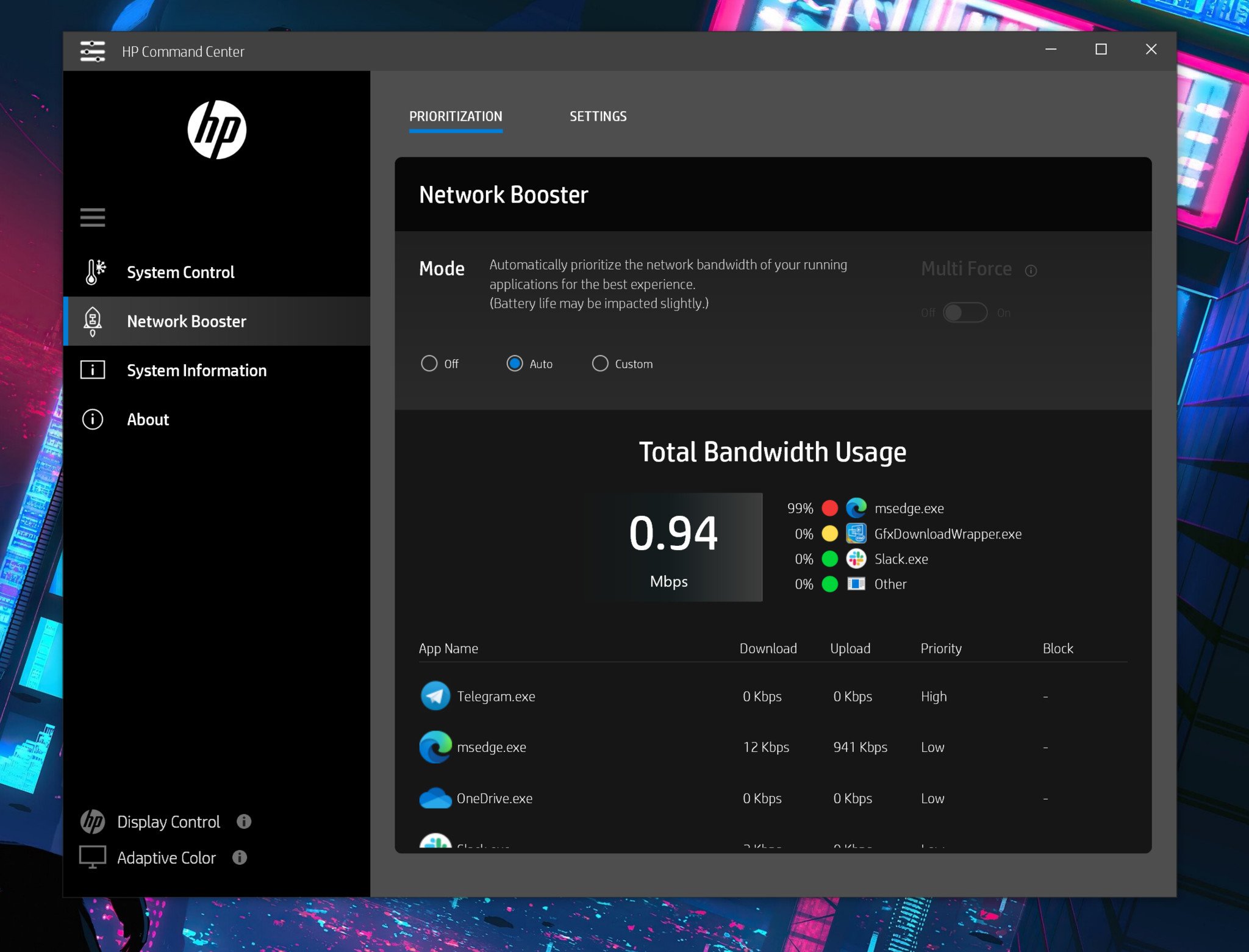
The battery is also quite good, even with OLED, getting around 7 hours of real-world usage. That's not groundbreaking, but it's actually very good for a 3000 x 2000 OLED panel. If the battery is a priority, the full HD+ model should hit 10 hours or more.
Looking at the competition
Spectre x360 14 (2020) Alternatives
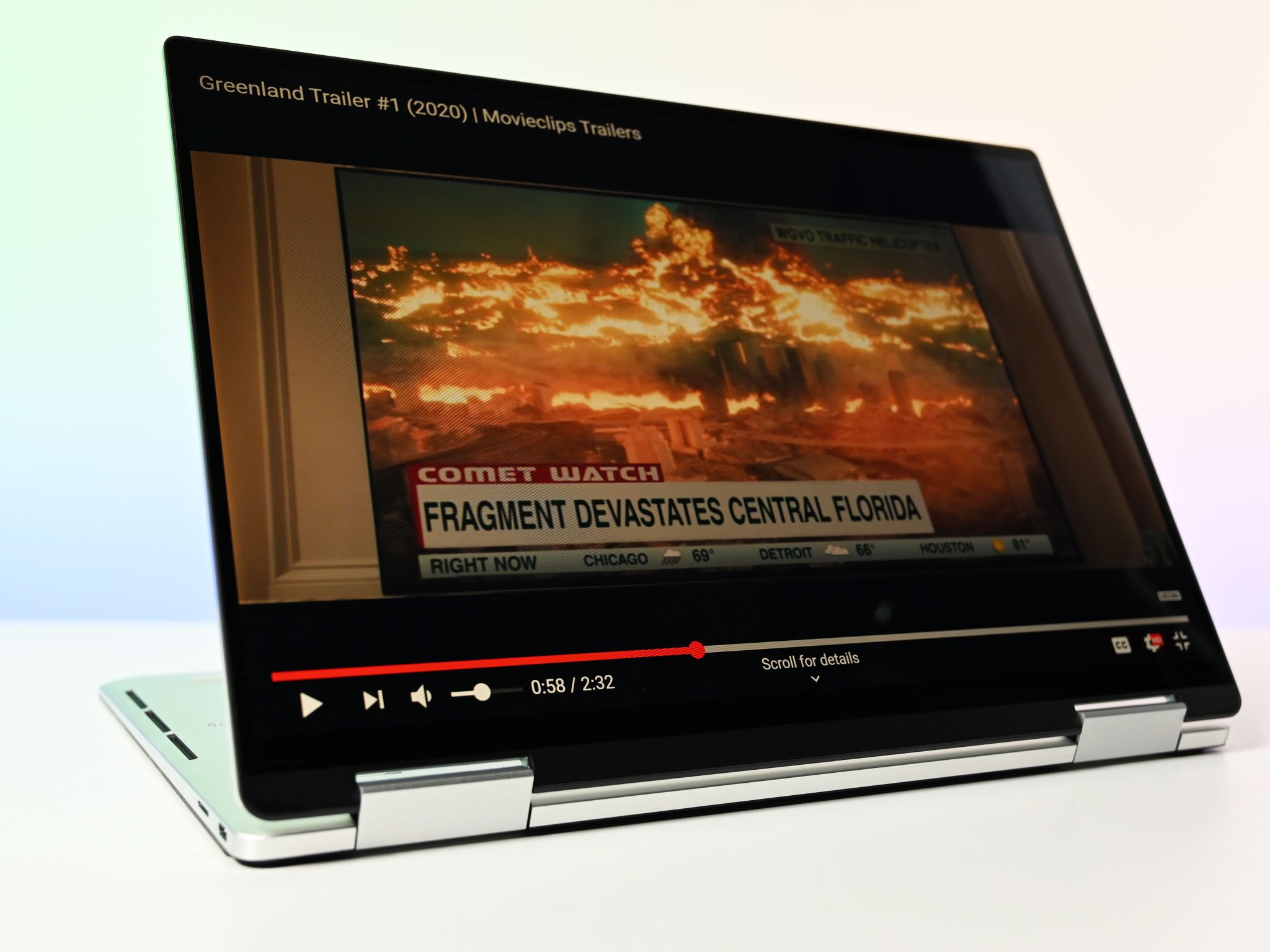
The most obvious competitor to the Spectre x360 14 is Dell's XPS 13 2-in-1, which has also been refreshed with the same Intel 11th Gen hardware.
Pricing varies; you could pick up an XPS 13 2-in-1 for $899, albeit with just a Core i3 and 4GB of RAM. HP's Spectre is currently running low on inventory, but pricing begins at $1,329 with a Core i5, full HD+, 256GB of storage, and 8GB of RAM. For $1,329, Dell offers a faster Core i7, 16GB of RAM, UHD+ display, and a 512GB SSD – twice the computer – making it the better deal.
This review used the model with a Core i7, 16GB of RAM, 1TB SSD, and that 3000 x 2000 OLED display, which costs $1,699. It can be found at Best Buy.
Both laptops are similar in concept, although HP gets credit for better audio with four speakers (instead of two) and shipping with a Type-A port, which the XPS 13 lacks. HP also has it privacy shutter for the webcam, a fingerprint reader, included pen, and a leather sleeve. And while Dell's keyboard is good, the Spectre's is more traditional with extra travel and larger keys making adjustment easier. The Spectre also ships with a taller 3:2 display versus Dell's 16:10.
Aesthetically, it comes down to personal preference as both laptops are gorgeous looking.
Lenovo also the intriguing Yoga 9i 14, which starts at $1,160. It lacks an IR camera, still uses a 16:9 display aspect, no Type-A, and anti-glare tech for the screen. It has the pen built-in to the chassis, excellent hardware design, and outstanding audio.
If you don't need a 2-in-1 design, the new Razer Book 13 is an excellent choice, as is Dell's regular XPS 13.
For more ideas, check out our Best Windows Laptop roundup for the creme of the crop.
A stunner of a laptop
Spectre x360 14 (2020) is the best Spectre yet
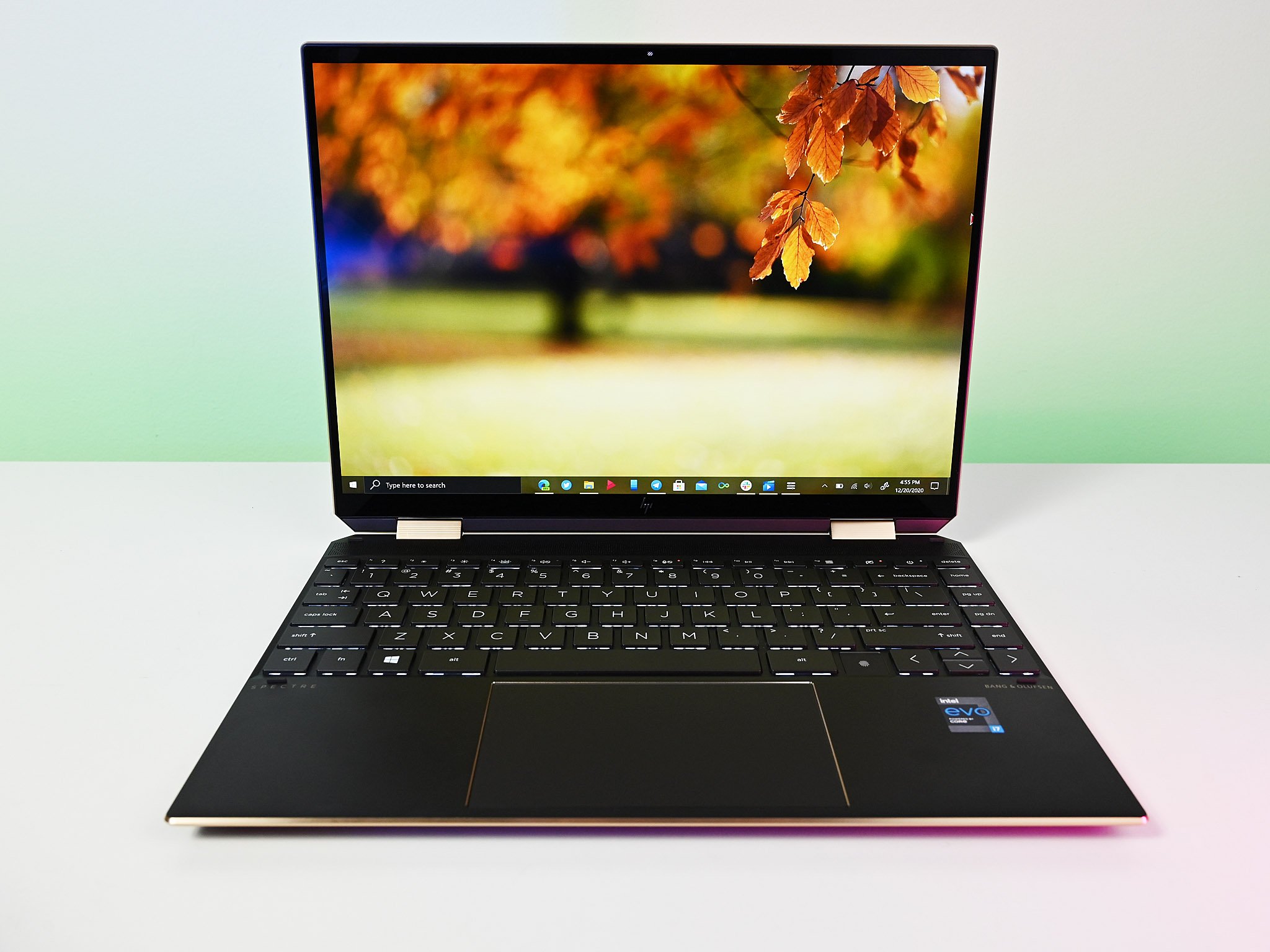
Who it's for
- You want a Surface Laptop, but a convertible
- You want an incredible OLED touch display with inking
- You like to watch movies and videos with excellent audio
- You want a fancy laptop that can almost do it all
Who it isn't for
- You need 4G LTE or 5G
- You want to game
HP is a fun company to watch as they do some great innovation and have a clear and unique design language. The Spectre series from 2015 and up has always done interesting things. But, HP can sometimes drag its feet on change, like adopting Precision drivers for the trackpad or moving away from 16:9.
The Spectre x360 14 finally brings all of HP's best innovations into one device. The privacy shutter, Sure View display, OLED, anti-reflective coating, quad-speakers, an excellent keyboard, etcetera. It ticks all the right boxes — it's just a fun laptop to use, especially for typing. HP has also fixed silly practices in the past, like side power buttons, thankfully.
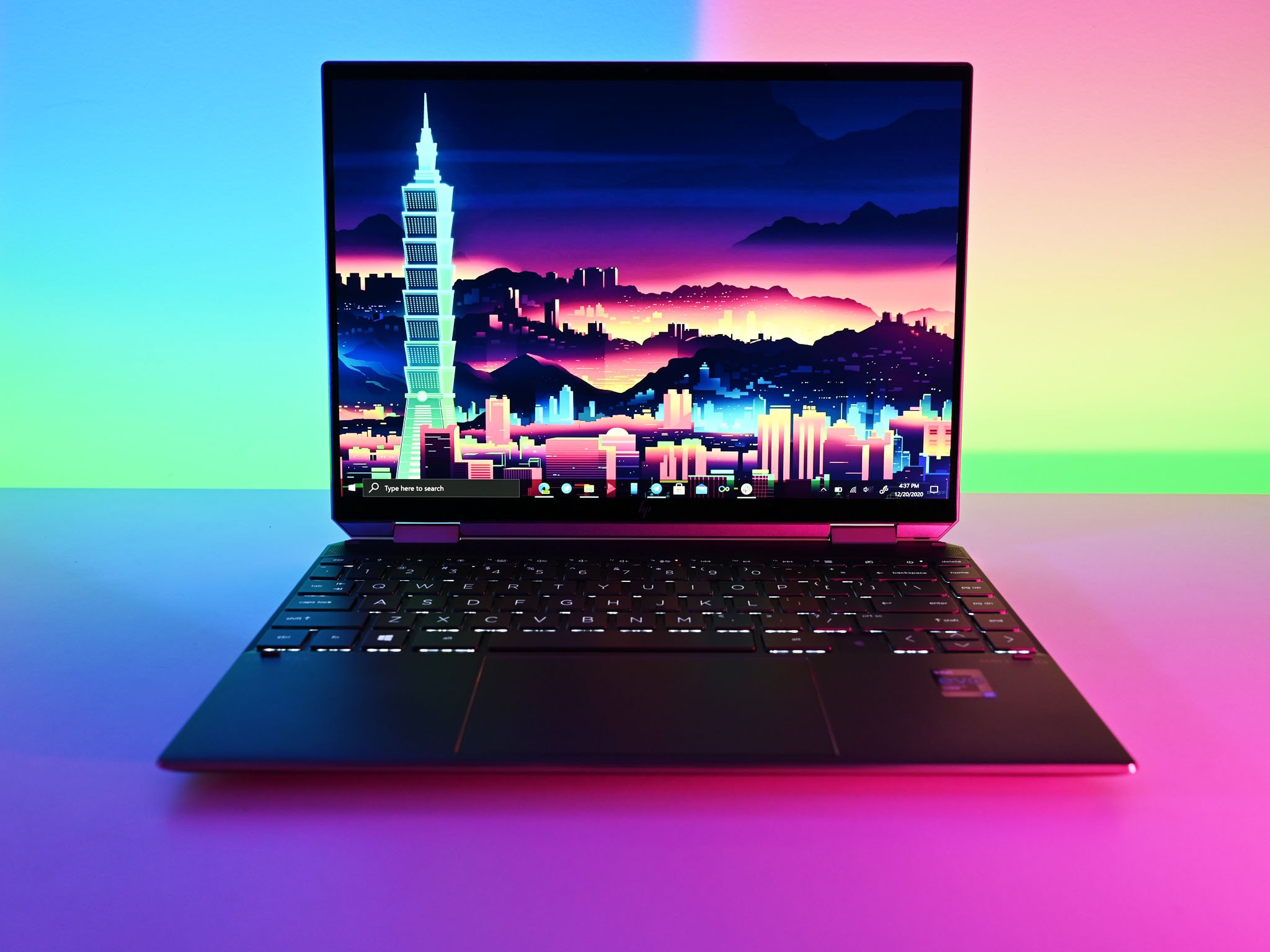
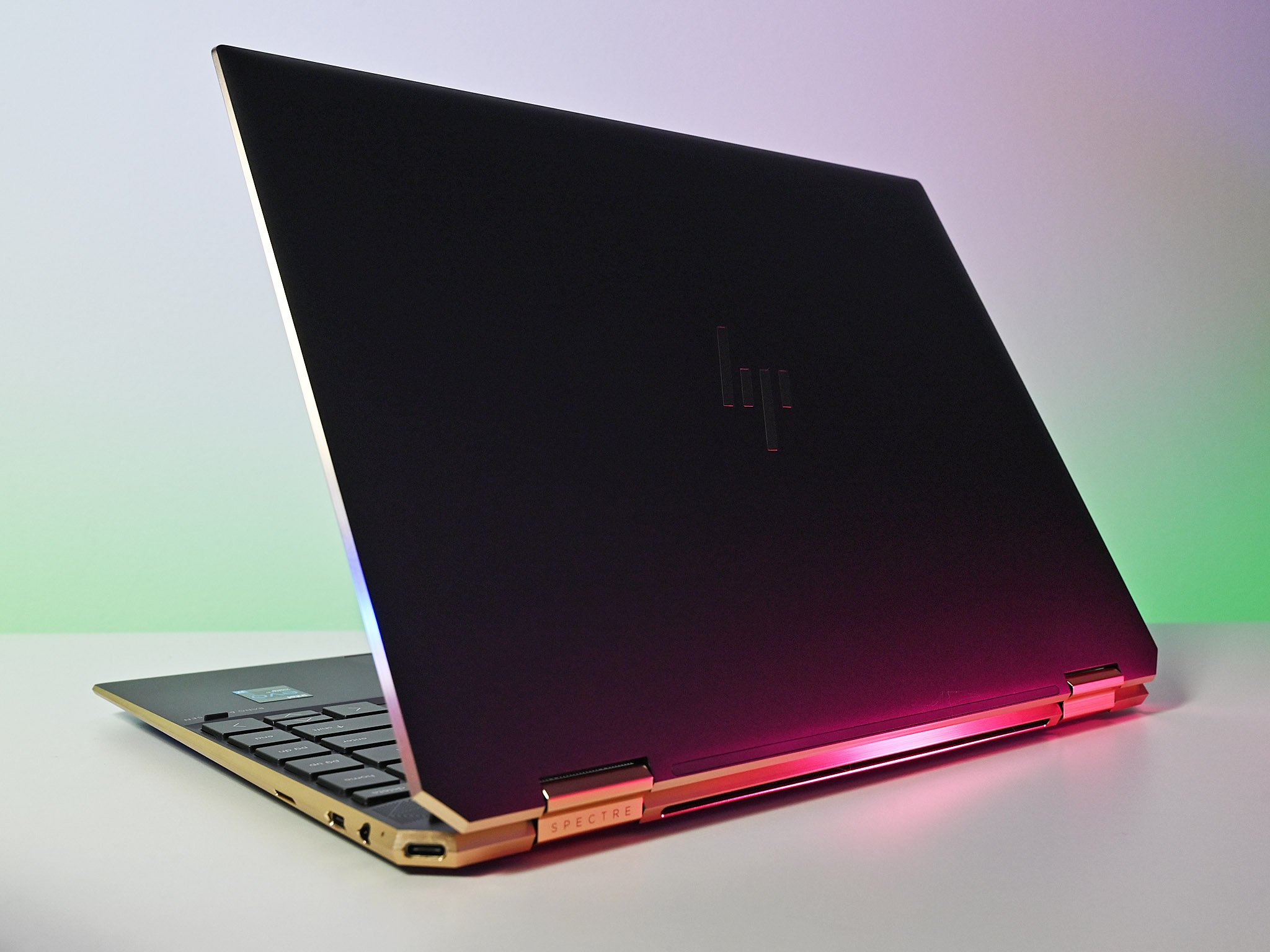
Of course, things could still be better. I would like to see HP tighten up the trackpad slightly and HP offers 4G LTE in its smaller Spectre x360 13, but it would be nice to see it as an option here too. Finally, while the gem cut design is distinctive, it may be a bit too flashy for some. I would not mind seeing HP go to a more minimalist design with 90-degree angles. I am also not entirely convinced Intel Optane does much for performance improvements.
Putting aside minor quibbles, the HP Spectre x360 14 is an excellent Ultrabook. Thanks to that 3:2 display, the Spectre x360 14 is basically a 2-in-1 Surface Laptop, which is something many have been asking for Microsoft to make. I don't see that happening any time soon, but HP's Spectre gets you things today like Thunderbolt 4, an option for OLED, and many other "smart" features that make it a better choice anyway, so go get one.

Bottom line: The Spectre x360 14 brings a gorgeous 3:2 display, outstanding quad speakers, excellent trackpad, and just the right number of ports to this top tier convertible laptop. Powered by Intel 11th Gen processors, all-day battery life, and an option for a stellar OLED display, this laptop has no flaws.

Daniel Rubino is the Editor-in-chief of Windows Central. He is also the head reviewer, podcast co-host, and analyst. He has been covering Microsoft since 2007 when this site was called WMExperts (and later Windows Phone Central). His interests include Windows, laptops, next-gen computing, and wearable tech. He has reviewed laptops for over 10 years and is particularly fond of 2-in-1 convertibles, Arm64 processors, new form factors, and thin-and-light PCs. Before all this tech stuff, he worked on a Ph.D. in linguistics, performed polysomnographs in NYC, and was a motion-picture operator for 17 years.
